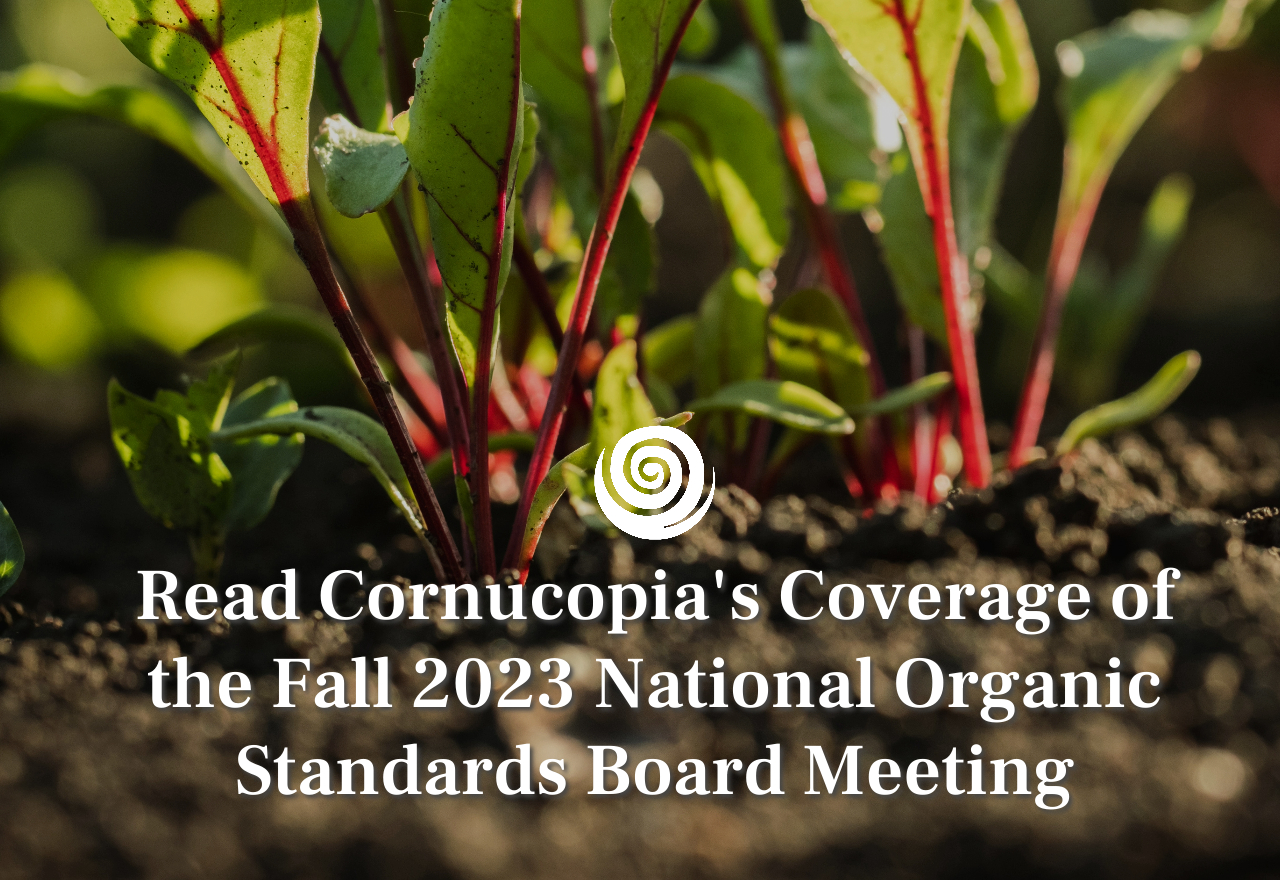Join The Cornucopia Institute as we keep you informed via web updates from the National Organic Standards Board (NOSB) meeting online.
We will be sharing the play by play of the meeting on October 24, 25, and 26 below.
For background on issues up for discussion at the meeting, see:
- The NOSB’s Proposals & Discussion Document for Fall 2023
- Cornucopia’s formal written comments
- Cornucopia’s notes on the oral comments for the Fall 2023 NOSB meeting
- Additional information on this meeting and past meetings dating back to 2012
Tuesday, October 24, 2023: Fall NOSB Meeting, Day 1
Call to Order, Agenda Overview, NOP Introductions
Jennifer Tucker, National Organic Program (NOP) Deputy Administrator makes some introductory remarks and introduces the NOP staff.
Dr. Tucker: We have new roles and saffpeople at the NOP: Heather Kumar and Esu Obu are scientific liaisons – new roles. Positions based on NOSB recommendations. We also have a new Associate Deputy Administrator. Previous Associate Deputy Administrator, David Glasgow, got job back home in TN. Andrew Malone is new Deputy Administrator and comes from Dept of Treasury -Alcohol and Tobacco team there and has significant labeling experience. Also Andrew was previously with APHIS. Been on board with NOP for a couple of weeks now.
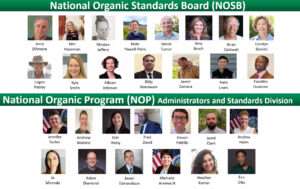
NOSB Introductions
Nate Powell-Palm, NOSB Chairperson
Role call of the NOSB members: Javier Zamora, Mindee Jeffrey, and Carolyn Dimitri are absent at the start of the NOSB meeting. All other NOSB members are present in person.
Current members of the NOSB can be found here.
Previous NOSB members can be found here.
Secretary’s report (acceptance of Spring 2023 meeting summary as official record)
Amy Bruch, Secretary
Minutes from April 2023 meeting are approved.
NOSB report
Nate Powell-Palm, NOSB Chairperson
Nate Powell-Palm tells his narrative about growing up with severe asthma and how his mother worked tirelessly to give him organic food to cure it. Nate also shares how he became a farmer and organic inspector. “Fighting for a future our kids can be proud of.” “Organic has been a refuge from economic violence.”
USDA/AMS/National Organic Program Update, and NOP – NOSB Q&A
Dr. Jennifer Tucker, AMS/NOP
NOP Update from Dr. Tucker: Learning Center is a free resource. Included TOPP update. Log-in to the Learning Center to catch up on presentation. NOP team has about 88 people with natural ebb and flow. Folks are distributed across 5 key groups: Standards, Accreditation, Compliance & Enforcement, Trade Activities, and Office Deputy Administration. 20-25 people b/w Accreditation and Compliance and Enforcement. Right now have team in India doing on the ground audits of certifiers there. Compliance and Enforcement process incoming complaints – half complaints are uncertified operations selling as organic. The other part of team is split b/w Livestock and Import Oversight. All concerned about Import Oversight and have a whole team dedicated to it. Trade team is all about international – about 15 people – didn’t exist 5 years ago. Include folks who oversee equivalency and recognition agreements. The rest are responsible for data and systems work. They work with import oversight group.
You can learn more about the NOP and the certified organic requirements at the Organic Integrity Learning Center.
The Office of Deputy Administrator runs the Transition to Organic Partnership Program (TOPP) as well as the Organic Insider, and work with the budget office. We also have a customer service team to field questions from farmers. About 2/3 are not in located in D.C. and are working remotely. We now have folks across the country.
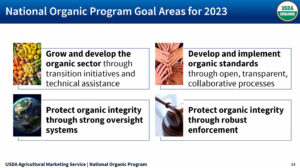
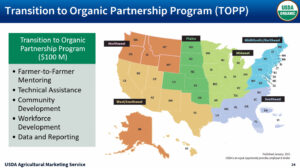
One year ago, we launched the first iteration of TOPP map showing all the partners. There are now more than 180 partners engaged at different levels. More than 165 events in just one year and in our online application system we have 80 formal applications to be mentors. We had through all events have touched 11100 people. Over 1000 people per month have be touched by TOPP per month.
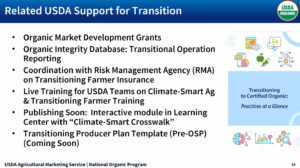
Transitional continues to be an extra-regulatory part of the program. Regulations don’t say a lot transition so we have issued a memo that we’ve issued. Not publicly posted data, but a way for us to communicate with RMA about who is qualified. Transitioning Farmer Insurance – making progress. Have also done live trainings for climate smart ad (over 120 people have taken part). Have micro learning in Learning Center for transitioning farmers. Interactive module on climate smart will come out soon. Soon we will publish Transitioning Producer Plan Template, a “pre-OSP”, a glimpse of what practices are and what transitioning farmers need to be thinking about (developed in collaboration with ACA).
We’ve been spending a lot of time and focus on implementing SOE. Stakeholder input on Farm Bill matters a lot.
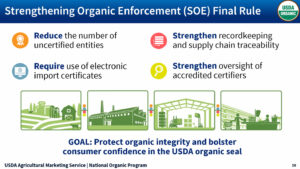
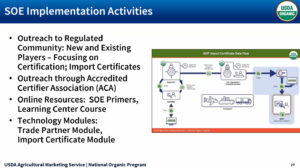
The NOP has been doing outreach about SOE through ACA. Trying to find alignment and consistency among certifiers. Recently launched learning center course about what rule says and why it matters – gives idea of what trying to do which is helpful in understanding implementation. Also been launching technology modules, including Trade Partner Module, to get them set up in OID. It’s called Global Integrity Database in which operations exported to U.S. will be reported. This module will issue import certificates. Certifiers can start generating import certificates – gave certifiers a head start. Have already generated scores of certificates. If you are wondering what certifiers are doing, ask them if gone into Import Certificate Module. If representing export community, ask how your certifier is getting ready for SOE. The module was launched 6 months before implementation.
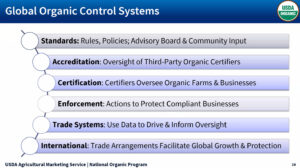
Certifiers have the ability to easily exit the market. If they can’t get into a country to do unannounced inspection, they shouldn’t be working there. This is example that SOE puts in place to tighten controls around the world. Trade systems uses data, CPB data, and updated MOUs about dating sharing across agencies and has opened up world of data. International trade arrangements intended to protect market – not just about standards, it’s about systems we use respectively to oversee the markets we control.
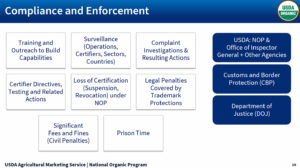
The NOP team has put a number of courses in the Organic Learning Center. The livestock team regularly posts a new course based on courses we are seeing. Done a number of courses on import oversight, quantitative methods, and math training. Surveillance on complex supply chains – if credible concerns about a region or tremendous growth in region, these are all indicators that we need to be ahead of the curve. We now have a team that can quickly initiate supply chain surveillance. Certification of everyone in supply chain protects all of us. We’ve issued a number of certifier directives – advanced testing, mass-balance and traceability exercises. New legal penalties covered by trademark protections. We have activated trademark protections in Customs and Border Protection (CPB) systems – gives us the ability to hold products and turn away shipments. CPB has special powers with trademark – often hold products at the border. CPB also charges to hold products at the border while under investigation. The goal is to make fraud to expensive to make it worthwhile.We also have seen cases of prison time for fraud.
Last week we had the team taking samples in Baltimore. This is extending to other ports. Through OIG work with DOJ on criminal cases.
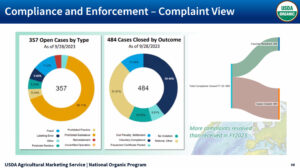
Voluntary compliance means the operation stopped the noncompliant conduct and perhaps paid civil penalty. Improvement in efficiency. We have resolved more complaints than we received. About 350 open cases. When cases involve OIG can be open for months or years.
![]()
When we close an NOSB recommendation we try to give a brief explanation of why. Have addressed over 90% of NOSB recommendations since the start. Regularly report to NOSB through memos which are publicly posted. We expanded memos with section that talks about regulatory priorities for upcoming semester. OMB regulatory agenda is definitive place to find out regulatory priorities.
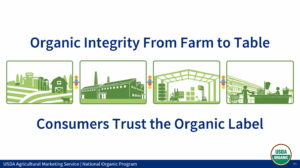
The NOP’s vision of “Consumers Trust the Organic Label” needs help from everyone in the room and listening.
Question and Answer: NOSB Questions for the NOP
Nate Lewis: Please elaborate on the SOE trading partners?
Dr. Tucker: We have trade arrangements with other governments where we have agreed standards achieve the same goal for fair trading. In my mind the system itself is important. How are the governments doing control system points. We have started conversation with other governments on updated equivalency arrangements which means they may need to make changes to remain equivalent with us. The EU recently updated regulations so we’ve started that dialogue. With Canada, dialogue has started with supply chain traceability audits – put in place before challenges emerged – so we’re having honest conversation about risk. We’re having a conversation with every trade partner and will be some difficult conversations. U.S. has put real investments in organic protections and raises bar for systems around the world.
Allison: Received comments encouraging us to look at equity commission and how we can build more inclusive organic sector. How can NOSB engage commission?
Dr. Tucker: TOPP program incredibly exciting and will hear from Northeast groups with incredible stories. Equity Commission background: put in place a couple of years ago and purpose is to make enduring changes to policy that eliminate system discrimination and oversight of civil rights issues. Secretary level commission – meet 4 times a year. They gave first report Feb 2023 with over 30 recommendations to advance racial justice. Agencies across USDA get a copy of recommendations and look at programs and see what we can do. Already been changes within AMS. Regional food business centers program is designed to assist small and mid-size producers overcome barriers including communities not previously been part of it before. Not waiting for equity commission – organic has been proactive in engaging tough conversation and one of national partners lead by OFA charged with bringing groups to conversation not previously part of conversation – takes us all having one conversation at a time. Lots of stories from folks not part of community that we want to hear and starts by asking what their story is. Encourage all to do that.
Brian: We get hundreds of comments from consumers and this time got a lot about toxics in plastics and hydroponics. How can we move forward and respond to these concerns about hydroponics and toxics in plastics?
Dr. Tucker: Plastics topic: zooming out, one of benefits of current food system transformation effort is helping consumers about where food comes from and how it’s produced. No denying there is a lot of plastic in all of agriculture. Organic is often a very focal point because of its openness and transparency for these concerns to bubble up. This is a broader experience in agriculture. This group has taken on some of that work on discussion on materials and in general. We have the National List deliberation process within this body’s work and you have used those well.
Hydroponics – another area where a lot of plastic is used, going to broaden out to containers and lots of questions about soil-based and soil less production. Containers is a topic that we are cognizant of and had a high place in regulatory priorities. Close after the 3 big rules: Origin of Livestock (OOL), SOE, Organic Livestock and Poultry Standards (OLPS) – those rules and advanced rule writing related to nitrogen and NL work have been a focal point. We hear that containers remains a priority for the organic community. We need to finish some of these rules [first] and effectively implemented them. And we want to emphasize OOL and done comprehensive review of certifier compliance. We want to make sure not just putting rules out in the world but following through on implementation. and enforcement. If container rulemaking were to proceed, need to be thought out. Some have said advanced rulemaking could be way – need to think about a policy process. It’s still on our minds as important priority for the community
Brian: If we can target known toxics with annotations; for example disallowing the use of PFAS or phalates in production of organically approved plastics – is that an avenue we could take? Plastic waste is a huge problem.
Dr. Tucker: Annotations are a valuable tool. Only comment is that as working on annotations, always have in back of mind what certifiers are going to have to do. Have certifier voices in your head when working on annotations so they can implement and enforce.
Amy: A message from heartland – times are tough. Corn and soybeans producers have limited markets and price compression. Many producers in corn and soy are taking acres out of production or contemplating doing so. I believe it easier to retain organic producers than transition new growers. Talk about concerns about bringing new farmers in grain world?
Dr. Tucker: Everything is connected. For TOPP to be successful we have to do enforcement activities. Have to have fair market. Import oversight program is making a difference – have seen large shipments that buyers in US refused and testing revealed prohibited substances.
In a difficult transition period to protect the market. We also have OTA partnering with Rodale hosting events to explain buying and what those contracts might look like. Also resources available to existing farmers don’t want to use. WE need to work on all fronts to have folks in US feel safe enough to make the jump. Why SOE is so important. If certifiers are overseeing exports, we need SOE to hold them accountable. Only through oversight and protection that people will feel safe to stay in the market. Import oversight, TOPP, strong clear standards – all part of a system.
Kyla: Several comments related to imports. Related to the testing – certifiers required to disclose results. Is there another way, NOP can be transparent on testing and results since still concern.
Dr. Tucker: Sampling and testing is important. Now that have CPB have a better sense of where to go and doing more targeted surveillance. WE actually know when ships arriving. Our annual enforcement report is avenue for doing more reporting. Farm Bill had reporting requirements. Along with that and our report, we report on the activities we are doing – fine line between transparency and letting bad guys know what doing. Don’t necessarily want everyone to know. When went to India did a broad testing program and lead to noncompliance for certifiers on the ground. If these are open noncompliances and not resolved, we move toward suspension. Very sensitive about showing had too much.
Jerry: In lag time for SOE to be meaningful. Believes fraud concerns will diminish rapidly with time [due to SOE implementation] and hang on to saddle.
Dr. Tucker: Sensitive about exemptions. A lot of emails say “only doing, then don’t need certification.” I find that alarming and if we get to next spring and summer, and exemptions, this only works if we are all in and not looking for loopholes. It will take time and already had a lot of time for folks to get certified. The rule is hard where the risk is high. It’s not supposed to be hard where risk is low. Want to read the rule in this context. Small farmers should not be overly burdened – it’s where the handoffs are where high risk.
Jerry: Dealing with segment of supply chain not used to having people tell them what to do. One segment still concerned about. Major retailers and even more from those who don’t know what don’t know. I’m worried about the clueless.
Dr. Tucker: Hoping level continues to drop every day. need to push the word out – how do I help – be thoughtful which stones throw. There might be a lot of stones in this room that have ripple effects beyond what we realize.
Nate Powell-Palm: [Notes that Carolyn Dimitri is now present.]
Amy: Even more difficult with geopolitical challenges, wars, and high-risk countries – can you speak to work on integrity with imports given these additional challenges?
Dr. Tucker: A number of certifiers overseas have exited the market due to no longer have administrative capacity. Keep an eye on the number of certified operations. Certifiers can only go where they can do unannounced inspections. What about NOP oversight of these certifiers working in countries where we can’t travel to? That is active conversation that team is evaluating. What are regulatory constructs around NOP capacity to oversee certifiers operating in those areas. If we suspend a certifier because they can’t inspect these farms what happens to those operation when the war is over – gets messy really quickly. On our internal work agenda that we are working our way through.
Carolyn: Realize conversations around organic are so much more complicated than ever thought before getting on the Board.
Nate Powell-Palm: Talk about cross-walk for climate smart. Could you tell us about climate smart cross walk? Organic should be considered climate smart. How have you taken proposal and build something out of it?
Dr. Tucker: NOSB started with a letter to the secretary outlining observations of administration’s engagement with climate change and talking about organic’s role in conversation. This turned into a work agenda. A lot of great feedback. Ended up being an NOSB recommendation. Developed nice piece and talks about possible offerings of NRCS and how regulations support climate smart agriculture. This ended up being a PDF document shared with others in USDA and we’re translating this into interactive module that we’ll put in Learning Center. Part of the goal is that if you’re an organic farmer and want to qualify for conversation benefits, for example, can more easily see what parts of OSP covers this. So much talk about regenerative, which makes the point that organic farmers are already regenerative.
LUNCH BREAK
Transition to Organic Partnership Program (TOPP) Presentations
Speakers and introductions are all for the Mid-Atlantic/Northeast TOPP. More information about the TOPP program can be found here.
Dr. Tucker: We are now moving to an update and presentation from the NE TOPP Region. Diana Kobus. I wanted to compliment this region. This region has a whole lot of states in it: includes all of New England and extends down into West Virginia and Virginia, and the whole Chesapeake Bay area. There are lots of states and diversity in farming practices and demographics in that region. I was privileged to join an early bringing together of partners and an early tone of collaboration in that region.
Dr. Tucker introduces Diana Kobus, the Executive Director of Pennsylvania Certified Organic (PCO), the Northeast regional lead for TOPP. Diana joined PCO in 2020 and has over a decade of leadership experience in environmental and public health professions. She has a masters in Environmental Science and Management and an undergraduate degree in English and Communication studies. She was the ED of the Institute for Environmental Professions. She also worked at Whole Foods market in the early 2000s and urged her to educate the public about the standards and food labeling. She brings a strong passion for organic production and was born and raised in Pittsburgh. She is there to help farmers at PCO and finds great joy in interacting with stakeholders.
Transition to Organic Partnership Program (TOPP) Presentations
Diana: The Northeast is home to leaders and where organic markets are yet to be developed. PCO intends to leverage a network of leaders. Have 9 core partners that includes 13 states and DC – highest of any TOPP region. We have termed the region a partnership, not a center, to represent our ethos. Our goal has been to create a strong network with a central contact in each state to create connections to transition.
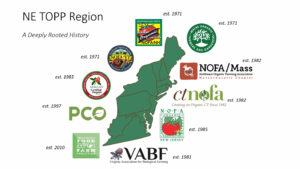
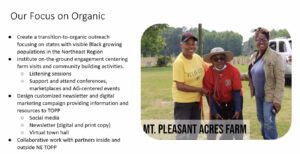
Featuring a mentorship dairy to tree fruit – Russell Wallack – 600 acres. Can look at Breadtreefarm.com. No interstate highways and barely one DMV. We believe this area could become breadbasket of NE. Stewards approximately 600 acres without toxic chemicals. Regenerative chestnut production. On mentor side, we have Brian Caldwell, founding member of NOFA NY. This is an example of farmer to farmer relationship TOPP is building.
The Transition to Organic Partnership Program (TOPP) was recently launched!
We are also working with the Black Farmers Index to increase diversity. We are eager to further connect the work of the organizations serving their communities. Foundational community building is work that builds lessons for all of us. This will provide a template for urban farms to transition to organic. NOFA Mass has created a program to have sovereignty over their relationships with the organic movement- addressing inequities in the process. Kaia Shivers is president of the Black Farmers Index.
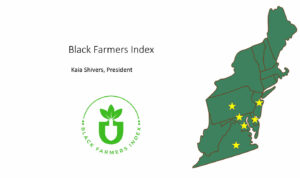
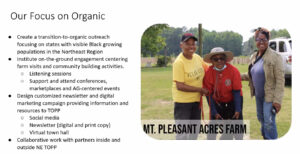
Dr. Kaia Shivers: Started the Black Farmers Index in April 2020. Who will be affected first when there is a food shortage, and how can I be part of the solution. As a result of being forced out of the agrarian lifestyle… commitment to bring as much food directly to consumers from farmers to answer how they survived generations of inequities. We now have 1200 growers listed in our index. Since expanding we are trying to ensure Black farmers are fully included. During our journey we were imbued with generations of agricultural stories, many of which were left out of the nation’s narratives. The methods used were organic and climate friendly, but they rarely used the term organic. Tradition. The old way. Heritage. Heirloom. So committed to the land were Black Agrarian societies, that farmers protested toxic soil being dumped in their communities which sparked the environmental justice movement. They were largely absent from the organic industry. These references to ecologically smart farming have been hijacked and remixed. They have a fraught relationship with USDA. If we cannot equalize organic now the whole industry will be impacted. Several people saw our work as important. Working with NE TOPP, we plan to use our on-the-ground relationships to build a community of growers who are certified to pass on a rich cultural knowledge of growing. We will be very busy. We will meet the farmers where they are literally, with intimate visits with honest conversations about needs, interests, and questions about transition. We will also work online for those who are savvy, and also with those who do not even own a computer. We will conduct town halls and listening sessions. We will customize a culturally competent experience. Farmers do not want handouts. Farmers do not want handouts. They want their space in the market and the resources and support that is owed to them. Dr. Ahmen studied in Japan to learn better rice harvesting methods. We helped him plant rice in May. Dr. Ahmen is certified and has become a go-to in Black farming but is undervalued in the larger organic space. Mt. Pleasant Acres farm, the “Aunties” are transitioning the land her family worked previously. This is the land Harriet Tubman’s family worked. We know farmers are committed to organic but are left out of the industry that has developed so many blind spots that must be corrected! Thank you for your time.
Diana: Thank you to Stephanie Jerger from OTA for connecting us. Each of us [in the NE TOPP cohort] have 2-3 minutes to talk about our states’ efforts.
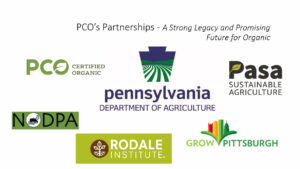
Pennsylvania: PCO shares responsibility for Maryland and Delaware. Challenge to transition is substantial and we are up for it. Pennsylvania is the only state with its own farm bill and home to most farmers under 35. Have opportunity and will lead transition. One event was Rodale’s Annual Field day where students learn from pioneers. PN Sec of Ag and governor came to support the work – governor said if want to grow economy, must invest in agriculture, and organic is key. PCO continues to build networks in support of TOPP.
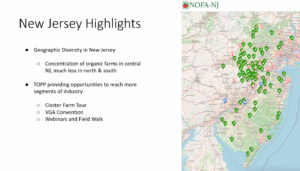
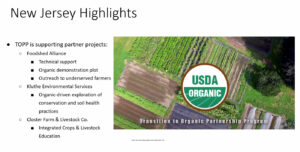
Devon Cornia from NOFA (NJ): New Jersey is a very diverse state. Organic farming has historically been clustered to the wealthy parts of the state. Through TOPP we now have the resources to reach more parts of our state that haven’t been there before. Relationships are the foundation for all of the work we do. We don’ t have great relationships within our industry- organic and conventional farmers don’t understand one another and organizations don’t always get along. We are working to get a fix on those relationships. This is a 10 year deliverable that TOPP will have an impact on. To repair these damaged relationships we are drawing conventional and organic producers together. We are having conservation webinars and nutrient management webinars to engage folks that aren’t as engaged in the more crunchy side of things. Webinars, Field Walks (livestock and crop farm), supporting underserved producers on an incubator site. We will be ramping up community outreach. I want to give a shout out to our partners. It has afforded us to work with these amazing people.
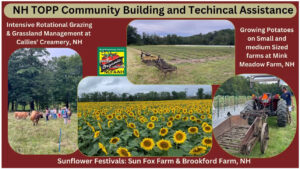
Teresa Downy: NOFA-NH is working with partners to develop events to assist transitioning farmers. Several on-farm programs have taken place and provided community building for those wishing to transition to organic. Grassland management workshop – farmers walked host farm fields. Another workshop, shared info on manure management from structures and materials to producing manure and managing manure. Another workshop involved strategies for growing potatoes where farmers were shown methods of field rotation, pest management, and restoring equipment.
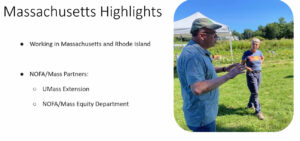
Laura Davis (from NOFA Massachusetts): I am a board member and organic certification assistance coordinator. I do some soil analysis as well. My job came out of Sound and Sensible. Since then I’ve been working to help farmers and food processors navigate the organic certification process. I also am an organic vegetable farmer and co-chair 7 NOFA chapters. Really exciting to me is our partnership with UMASS Amherst with their ag school. They had always told us they teach people how to farm. IT’s up to the farmer if they choose organic or conventional. We were able to sign them up to develop and deliver a series of 7 workshops for organic growing. This is a picture of me and Congressman McGovern. He brought 30 people to my farm in August (NRCS, FSA, Rural Development). He said we have to get the word out about TOPP! He has been a big supporter of agriculture.
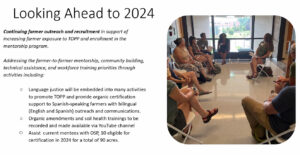
Diana already talked a little bit about the NOFA Mass Equity project. We have been working on equity for 6 or 7 years. Dismantling racism trainings happen every 2 weeks for staff and board. That has made a difference for the board, staff, and those who come to our conferences. This has helped us to reach farmers of color.
We are looking forward to continuing our outreach. Figuring out how to crack the nut of getting in front of conventional farmers. We have 10 farmers signed up to transition. They are all growing organically now… how do we get those Farm Bureau people to sign up? We have 10 ready to go and they are all eligible in 2024. Our mentors and mentees will be able to take advantage of the soil health services we offer. We appreciate this opportunity!
Chris Grigsby (Certification Director at MOFGA): Working with project partners, Univ of Maine, Maine Grain Aliance, and University Maine Cooperative Extension.
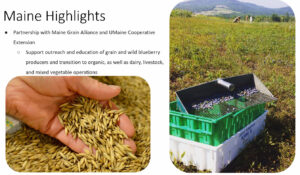
Maine Grain Alliance will train and host organic heritage grain workshops. Partners will be hiring staff to support TOPP.
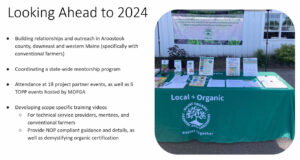
Teddy Tomao: NOFA-NY Long Island Transitions Coordinator and new farmer.
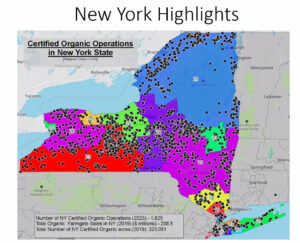
NY is the 2nd in nation for certified farms and still area to be improved. 4% of land is organic and this is about same as CA and Maine. Vibrant agricultural infrastructure and diverse production of crops. Great opportunity to transition more acres – including wheat, rye, and pulse crops. Have continued regional demand for local and regional organic dairy. For last year and half, I have been Long Island educator. With TOPP able to expand reach and can now add 3 educators to cover NY state. Have events throughout state. Have winter conference in January and planning regional events. With partners have been putting on events and now TOPP gives us opportunity to collaborate, expands reach. Done TA and workshop improvement – dairy practices, vegetable growers, and improved info on certification. TOPP has really helped with mentorship program. Matching farmers and it’s revitalizing us.
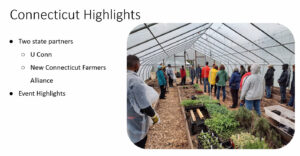
Jeremy Pelletier with NOFA Connecticut: Thank you to PCO for their leadership. I am the ED of NOFA Connecticut. In Connecticut we have a unique situation in that we have a tightknit ag community. We work well with the various players (Farm Bureau, Extension, etc.) We have 66 or 67 organic farms in our state. We are able to reach out to many organic farmers, transitioning farmers, and those who have shown interest. We have learned specific barriers to entry of becoming certified. Partnering with UCONN, we have provided TA and our Getting Started in Organic Farming will detail everything from land acquisition to organic application.
Our strength in Connecticut is with our partnerships and ability to provide technical assistance. We have 10 mentors and 9 mentees. UCONN will, for the first time ever, have an in-house organic farming specialist. They will extend their services to all farms. We are very excited about that. This will include general support. The Farmers Alliance will build cohorts and community among transitioning farmers.
Lastly, we have an organic certification expert on staff to walk farmers through the certification process. Our goal is to provide support at all points so that we can 1) ensure a successful transition, and 2) demystify the process. Thank you!
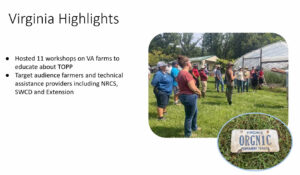
Brent Wills, Program Coordinator, Virginia Ass for Biological Farming. From Blue Ridge mountains in Virginia. Raise pasture raised pork. Get to work with other farmers who are learning organic and regenerative methods. Have few organic farms and processing in VA. There have been gaps in educational programs and being able to partner with PCO and other organizations allows us to provide much needed technical assistance. Able to extend outreach to increase awareness of organic in VA. Have a lot of gaps and wide geographic and demographic changes. Decided to focus on training the trainer. Most exciting things looking forward to is having 2024 winter conference in Roanoke, VA. It will focus on TOPP project and devote a full-day specific to organic production and it’s free for all attendees. Will also provide different workshops regionally across the state. VA is a wide state and agriculture is different in the west than in the east. Partnering with VA State Univ. b/c they are solid partner in equity in organic production. Work with farmers of color and expand diversity and looking forward to being a partner.
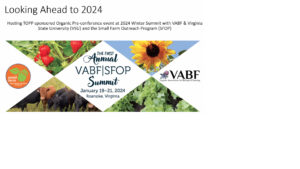
Spencer Moss, West Virginia: I’m the Executive Director of the West Virginia Food and Farm Coalition (WVFFC). We’ve had a little less organic action over the year. I discovered that we have about 21 certified organic farms. At the coalition, we are a statewide coalition, based in Charleston. We work at the intersection of farm viability and food access. We create programs, policy advocacy work, offer help getting farmers to work together collectively. We just filed the paperwork, after working as a group for 2 years, for the Mountain State Co-op!
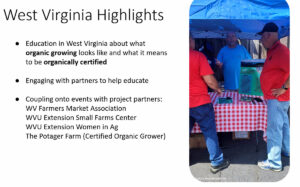
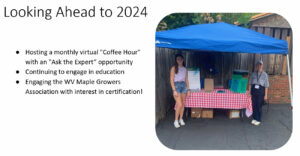
What we already knew is that our farmers often utilize organic practices. They believe in the tenets of organic and in soil health. We learned that they aren’t necessarily interested in certifying right now due to the expense and the paperwork, and having someone on their farm they don’t necessarily want there. They are not getting a price point back that warrants the additional work on their part. I have my fingers crossed for some action there. We are using the TOPP program to conduct outreach and education about the benefits of organic practices. We have 3 mentees which are part of the Mountain State Co-op group. We are working with New Roots Community Farm and the West Virginia Maple Producers Association. Looking forward, in 2024, we are excited to do more events, outreach, grow our relationships, and introduce a virtual coffee hour. It will include a 30 minute ask the expert time to make this work less scary.
Nicole Dehne, VT with Vermont Organic Farmers (VOF): I’m the certification manager for VOF. I’m here to talk about why TOPP is important in Vermont. Starting to see a decline in number of certified operations. In 2022 saw a 2% drop and expecting a similar decline by end of this year. Some is the organic dairy crisis, some farmers are retiring, so it does feel like an opportunity for TOPP to address. Record keeping requirements mean producers need assistance in navigating requirements. How we’re implementing TOPP – model of partnership.
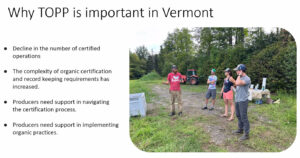
More maple producers than any other type of farm in VT. With assistance from partners, implementing farmer to farmer mentorship program. Also offering one on one technical assistance to growers all with goal of making certification more accessible and understandable.
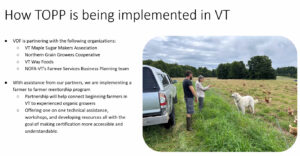
Diana: We are grateful for this group and the way we find ways to work together. We’ve watched the TOPP process and across the country. I want to recognize our other regional leads for the way they have been doing this work together. Thank you, too, for our team at PCO and their team effort!
Questions from the NOSB to the TOPP presentors
Allison: There are 3 pillars in organic transition – one of things that is important in regions with fewer producers is financial assistance during transition time – are you getting the support you need to help producers connect with conservation programs and pay them for public benefits they provide.
Diana: We have been talking about wanting more involvement from NRCS. That pillar of the three could be deployed more easily. That’s an active discussion and an area in which we could use more support.
Allison: Farm Bureau came up a couple of times. One positive existing relationship, and others where it could still be built. How could we leverage the relationships that exist to build support within others to reinforce the TOPP work?
Diana: I think that community building is a deliverable. We are all working on that issue. We have to step into spaces not traditionally comfortable or welcome. We are trying to recognize challenge with grace and patience. Any farm bureaus, local or state, we’d love to be working with you.
Dilip: Thank you for your presentations. I have two questions for Dr. Shivers and one for Laura Davis. I’d like to applaud Dr. Shivers efforts working with Black Farmers. We heard yesterday that 98% white and 1% Black farmers in the US. You mentioned that you’re reaching out to the US Virgin Islands. These are very unique. I work with those organic farmers on those islands and I know the challenges they are facing. How are you reaching out and supporting them, which need a lot of help and support in organic production. They really are going through a lot of challenges.
Second question: Are you working with 1890 institutions. They have mandates to work with African American Committees.
For Laura Davis: You teach organic and conventional farmers. How do you motivate them to try organic farming? How do you encourage them?
Laura Davis: How do we motivate conventional farmers? One of things we’ve done is to educate them on little farmers underneath the soil that are being killed by chemicals. We have active microscopes so they can see what is alive in their soil and they get really excited if they see organisms moving and alive. So we start where they can appreciate that and have horticultural growers who have reduced reliance on chemicals and increased biology. By looking at it that way and not attacking on chemical use then they can learn and evolve. Excited about UMass involvement b/c conventional farmers tend to look to UMass about what is going on in the field.
Dilip: Life below ground is very important and plays a vital role in organic farming.
Franklin: My question is related to Dilip’s. Did you encounter attitudes towards transition? Did you learn anything you didn’t expect?
Diana: One of the benefits and joys of working with strong leaders is that anything that comes up we have tackled together or worked on a solution. I can’t think of any particular challenges. Jenny mentioned that our region is socially challenging. Population centers and rural tracts. There have been some honest discussions about demographics and how we support one another. This group in the Northeast has been a joy to be a part of.
Kim: Similar question to Allison’s, talking about partnerships in conventional space. Can you expand on NE grain growers co-op and successes and roadblocks?
Nicole: We’re partnered with the NE Grain Growers cooperative. The biggest hurdle we’re seeing there is the market. Some of that is being addressed by the other arm- market development funding. We are not seeing as many mentees in that area as we had hoped due to that roadblock.
Amy: This was inspiring to hear how TOPP is being executed. Dr. Kaia, I loved how you said farmers don’t want handouts and you mentioned importance of competitive markets. What are top 3 areas we can work on in terms of market development
Dr. Kaia Shivers: a lot of farmers farm I food desserts so they don’t have a market locally. They would like to have more markets where they live. They also need support in terms of getting it to market and processing facilities. Lot of racism in processing facilities – food getting stolen, for example. Need to feel safe where can get food processed. Also need “marketing.” some type of support so they know they are growers and that people know there are black farmers. People thing they don’t exist. And another one, is black farmers need support getting into farmer’s markets and the system in place does not take into consideration the farmers that don’t have Venmo and cash app – push for technical assistance so they can be competitive at farmers market. Fifth, there are row crop farmers so in commercial space I challenge those big companies to reverse how they consider those who grow, meaning they have contracts built out for collectives that are not opening to black farmers so what else is needed is conversation with bigger companies how are they creating something that allows black farmers to compete in collectives or create BIPOC group.
Back to Dilip’s questions:
Dilip: Thank you for your presentation and for reaching out. I have two questions for Dr. Shivers and one for Laura Davis. I’d like to applaud Dr. Shivers efforts working with Black Farmers. We heard yesterday that 98% white and 1% Black farmers in the US. You mentioned that you’re reaching out to the US Virgin Islands. These are very unique. I work with those organic farmers in those islands and I know the challenges they are facing. How are you reaching out and supporting them, which need a lot of help and support in organic production. They really are going through a lot of challenges.
Second question: Are you working with 1890 institutions. They have mandates to work with African American Committees.
Dr. Kaia Shivers: We also work with the southeast region with Florida Organic Growers has a growing relationship with HVCU’s. started index in pandemic so communication was far and few between. We started going straight to farmers. Many have relationships with extensions. HVCU’s severely underfunded and in a lot of legal quagmire. How do we get funding to go directly to the farmers. Needs to be a lot more support. USVI and Puerto Rico – a lot of work done digitally still. USVI has been more represented on index b/c mostly English based organization. Have brought on interpreters. Right now, communication is digitally and one organic grower on USVI – a lot are practicing organic, just needs more support on infrastructure b/c everything costs more. Same thing with Puerto Rico – process is so expensive and cost of living on the islands.
Jerry: Your enthusiasm is infectious. I’d like to note that yesterday, NOC had a grower panel, mostly local. Mr. Spear, a Native American fielded the same question of what do you need… the answer also wasn’t money or a handout, but it was powerfully said. He said, “we need a seat at the table.”
Dr. Kaia Shivers: He said I’m a Native Farmer. I said- second time is divine- what are we going to do together?
Nate Powell-Palm: Describing several colleagues who are binary and black farmers. How do we elevate their voices?
Dr. Kaia Shivers: pay them. I recognize that farming is a business. When you want them to come, pay them for their time. They are always farming or thinking about it. Two, you have to give them a platform how they speak and see things without correcting them. And then there are cultural things – a lot of people tend to look at people of color as being at a deficit. Farmers operate through ancestor and lineage. Before I had inroads, I had to give my family tree. Tend to see same farmers at every function and don’t represent expansive farming community. Want to diversity and what they call farming. Only on record on 2 black-owned farms that own 1000 acres or more. One is fighting for land in Colorado. Plan events around growing system – winter or low months. In Louisiana, we meet farmers at festivals that they grow around. If you can meet them, they will talk, in between that they are growing.
Spencer: What is the Co-Hops, co-op?
Spencer: It was originally around growing hops. 8 farmers to get ¼ acre hops yards up and running. They have already expanded to allow value added producers into their co-op.
Dr. Tucker: Let’s all give a huge round of applause for these speakers!
Livestock Subcommittee (LS)
Kim Huseman, Chairperson
We have nine Sunset Reviews for the Livestock Subcommittee this afternoon.
2025 Livestock Sunset Reviews
All details about Sunset Materials can be found in the NOSB meeting materials [PDF].
Alcohols: Ethanol and Isopropanol
Nate Powell-Palm: I reference back to the panel on sanitizers for these materials. The panel said you need lots of options you can rotate through, so you don’t become too reliant on one santizer. The community says these are both good options to keep in the barn.
Amy: Comment on stakeholder comments: the accessibility to alcohol is good, meaning you can find it everywhere. Easy to use and access, both are important.
Nate Lewis: Do you have any info on the availability of certified organic alcohol?
Nate Powell-Palm: That was not part of the discussion. Note that due to absences, 9 is the supermajority this time for voting (only 13 NOSB members are present).
- Motion to de-list Ethanol. Yes: 0 No: 13 Absent: 2 (Zamora and Jeffrey). Motion to de-list fails.
- Motion to de-list Isopropanol. Yes: 0 No: 13 Absent: 2. Motion to de-list fails.
Aspirin
Kim: Aspirin is a relatively straightforward way to provide pain relief, is easily accessible, available, and well-understood. There were not any negatives to keeping this on the National List.
- Motion to de-list Aspirin. Yes: 0 No: 13 Absent: 2. Motion to de-list fails.
Biologics – Vaccines
Brian: We love these slam dunk kinds of reviews, but vaccines isn’t one of them. Vaccines are critical for livestock health and success of livestock farms. In general, they are quite effective. The issues arise with vaccines made with excluded methods (GMO/genetic vaccines). One reference allows for unqualified use of vaccines, and another regulatory reference is more specific and allows vaccines with genetic engineering to be used but with qualifications. In 2014 the NOSB made a recommendation to only allow GMO vaccines when an equivalent non-GMO vaccine is not available. This recommendation has not been adopted yet.
In spite of important concerns over non-active ingredients and the GMO status of many livestock vaccines, the Livestock Subcommittee feels that the need for effective vaccines is critical for livestock production. Since the 2019 recommendations have not been implemented at this time, the Livestock Subcommittee has adopted the following interpretation:
- This sunset review encompasses the entire class of synthetic livestock vaccines, including those made with excluded methods. The Livestock Subcommittee encourages the NOP to adopt the 2019 NOSB recommendation. In the meantime, our interpretation is that this listing fulfills the requirement at §206.105 (e) for all livestock vaccines.
NOSB member: Can you put that statement in laymen terms?
Brian: Two listings for vaccines. Since that 2019 recommendation has not been implemented, this review says that all vaccines can be used. It’s a matter of practicality and the importance of vaccines. This is a blanket approval of all vaccines. The alternative would be to review every synthetic vaccine GMO or not – or just review every GMO vaccine, or basically saying they are all in a blanket approval. It’s not a great solution but it’s the only thing we can see going forward.
Allison: This is messy when we have an outstanding recommendation. My understanding is that if we were to limit use of vaccines, it would increase need to use antibiotics and pull an animal out of organic production? Is that correct?
Brian: Some diseases that vaccines treat for can be treated with antibiotics, but often it means loss of animals.
Nate Lewis: Many states have vaccine requirements so vaccines are needed to participate in a livestock market.
Unidentified NOSB member: Does this conform to everything else we do. Can we challenge this decision later.
Nate Powell-Palm: Yes.
Wood: Why has the 2019 recommendation not been adopted.
Dr. Tucker: It is on the list as “on hold” because there were other priorities we need to move ahead with. This was not rated that high in that regulatory priorities list.
Dilip: I want to understand that what we are voting on today includes excluded methods.
Brian: Maybe it would help that I explain that the 2nd listing in OFPA specifically says that under excluded methods that they cannot be used in organic EXCEPT for vaccines. There is an explicit exception. The writers realized this was such a thorny issue. For some diseases non-GMO vaccines are not available. Rock and a hard place.
Nate Powell-Palm: The power of this is so important for keeping us going as organic livestock. Farmer representatives, including CROPP cooperative (organic Valley), this is a fabulous bright spot in organic that we said “all vaccines are allowed”. Make sure we never but our livestock are not using the best preventive medicines and makes it easier for certifiers as well. It seems reasonable we won’t but this burden on the certifiers. Understanding the concerns of the community – we acknowledge the 2019 recommendation – but we also don’t want to become the “disease Mary” that defines organic.
- Motion to de-list Biologics – Vaccines. Yes: 0 No: 13 Absent: 2. Motion to de-list fails.
Electrolytes
Brian: Electrolytes are used to treat imbalances that cause severe pain and death. They are essential based on livestock comments.
- Motion to de-list Electrolytes. Yes: 0 No: 13 Absent: 2. Motion to de-list fails.
Glycerin(e)
Kim: Having glycerin as a teat dip as an alternative is something famers say is necessary, with a nod to having multiple options. Through Spring comment, most were very supportive of keeping it on the NL. There was a request to validate the methodology through which glycerin is being manufactured. Certifying bodies responded that their way of validating that the glycerin was natural was that it was manufactured via hydrolysis (of fats and oils).
- Motion to de-list Glycerin(e). Yes: 0 No: 13 Absent: 2. Motion to de-list fails.
Phosphoric acid
Amy: After the spring meeting the NOSB reviewed concerns from stakeholders (possible action items): rise or no rinse, downstream equipment (like milk bulk tanks), material review (to determine issue of inerts – are their multiple products in the phosphoric sanitizer meaning you should rinse? Or no rinse?). There is an active ACA working group.
Kim: The materials working group discussed this material. This also applies to the Handling Subcommittee. The inconsistency with how certifiers would review is broader and applies to all sanitizers, and there are different practices for how they should review sanitizers broadly. The annotation for this listing is verified like any milk house sanitizer, affluent, etc. There was discussion around the livestock and handling listings and how or if to align them, and how and if to fix the annotation.
Amy: We had seven comments supporting re-listing. One from a farmer group said it is essential, needed to remove deposits that cannot be removed. Advocacy groups mentioned Environmental and health concerns. Phosphate pollution can degrade water bodies. There were comments asking for improvement with the listing. For handling, there is a little difference in how the listings are annotated. Stakeholders appreciated the more-defined listing in livestock and hopes that it would carry over to handling.
- Motion to de-list Phosphoric acid. Yes: 0 No: 13 Absent: 2. Motion to de-list fails.
Lime, hydrated
Kim: There are quite a few materials that we will see across the different subcommittees. We will hear about this again during the crops review. In the case of livestock: through the Spring comments, most were in support as it is a necessity for good management practices for livestock. Another tool in the toolbox. One commentor brought up that some uses that may not be intended (like using it as a deodorizer). Something to keep on the radar. When reviewing for the fall, all other comments were directed to crops subcommittee.
- Motion to de-list Lime, hydrated. Yes: 0 No: 13 Absent: 2. Motion to de-list fails.
Mineral oil
Brian: Highly refined petroleum oil, sometimes called white mineral oil. Effective and shelf stable against external parasites which can cause serious animal health problems. This listing is for external use only. There is a second listing for internal uses. It also includes lubrication, usually for artificial insemination. Comments were 3 in favor of re-listing, certifiers noted lots of use by their farmers.
Kim: Is there a benefit to coupling the two mineral oil listings and having them at the same time for Sunset review.
Brian: I think that would be great, which means this listing would be reviewed in 3 years rather than 5.
Kim: We have another example of that with xylazine and toulzine. It would take away some of the confusion by having them go through process at same time.
Amy: Are there any natural alternatives that are out there and effective?
Brian: I’d have to look into TR for that. Lime sulfur is used for similar purposes. It’s good to have a variety of tools and it’s highly effective. There might be alternatives but this is in standard usage.
Amy: Didn’t know if there is market expansion opportunity for other crops.
Nate Powell-Palm: I don’t want to have a dirty mind in the gutter but wanted to note your entrepreneurship Amy. I use this material to do AI with my own cows. I haven’t found a good analog to use.
- Motion to de-list Mineral Oil. Yes: 0 No: 13 Absent: 2. Motion to de-list fails.
NOSB Livestock Discussion: Organic Pork
Kim: I will not be running for chair of the livestock committee next year.
Nate Powell-Palm: Since we’re running ahead of schedule, mention swine production – we have a chance to think about other areas we could bring to light. Putting it out to community that I don’t see where the market is yet, calling for organic pork, or do have a lot of farmers that want to grow it. Who are those organic pork buyer or brands. It’s easy to round up farmers to tell us best strategies, but we need to know there is a market when we get folks to transition.
Kim: We had robust conversation in LS regarding swine. We altered our research priorities and it now includes swine production. I’d like to encourage land grant universities to figure out ways to put dollars into research. No only from buyer aspect but also challenges of swine production in organic format. It’s a holistic process: yes, you have to have buyers but what comes first? So many challenges in this space.
Carolyn: As part of organic swine conversation, have to consider processing capacity. The whole entire food system rather than just the two end.
Brian: anecdotal comment – our local super market always has organic bacon. For many years had organic ham for cold cuts. I don’t see why there wouldn’t be an organic market for hams, bacon, and sausage. Quality that we can get when it’s available is very high.
Wood: Why would there not be a market for this product? Amazed by comments on this.
Nate Powell-Palm: There is a cooperative working on a pig pool. Folks are trying to access markets. As inspector inspected 1 maybe 2 organic pig operation out of over 3000. How does organic hog grower access middle production point.
Carolyn: What happens to the rest of the pig f you end up with bacon in the store.
Kim: Organic casings!
Nate: Put on the table the aquaculture and wild caught seafood standards.
Nate Powell-Palm: Reconvene tomorrow with CACS.
END DAY 1.
Wednesday, October 25, 2022: Fall NOSB Meeting, Day 1
USDA Risk Management Agency: Risk Management Agency (RMA) presentation
Francie Tolle, Director of Product Administration & Standards Division
Dr. Tucker: Introduces Tolle. Joined RMA in August 2015 as Regional Office Director in Oklahoma City. Previously served at Oklahoma FSA and as policy analyst, and others. She was named 2000 Oklahoma Ag Woman of Year. Native of Oklahoma, she farms with husband, and now raising 7th generation on a farm. We collaborated on how we get transitioning farmers under our framework by having them listed in OID to provide on-ramp for transitioning farmers to be in the system and acknowledged by RMA.
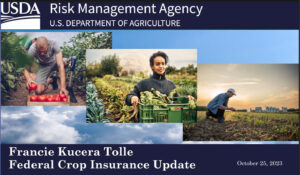
Francie Tollie: I have been on farm all my life. One son farming full-time. Going to hit some high level areas of crop insurance and the report that came out that you guys will discuss. Hear crop insurance doesn’t work, but not specifics of why. At RMA there is a big desire to bring everybody in crop insurance program. No reason we should not. If you are farming it’s incredibly capital intensive. Crop insurance helps farmers sleep at night, way to get a loan. It’s important for everyone. Trying to work through this very important. Will hit high points and what’s in report – this is just first conversation we’ll have.
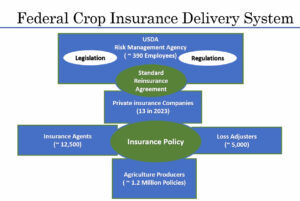
Federal Crop Insurance Delivery System (slide): We work different than other agencies. We have 390 employees, small, and our delivery system though is very large. Improved insurance providers (12 in 20223) and they have agents they contract with (5000 adjusters) and they work through insurance policy with the producer. We have the largest safety net, but smallest agency. When we look at what implement, we look at legislation and have authority to develop programs. Some insurance that’s been out awhile are codified – so when we do a regulation it’s because producer group has said want to change the policy. Crop insurance is the same price for producer wherever you go. This crop insurance or that gave better deal – no they didn’t — it’s same wherever you go. What may be different is agent may be offering different options, different coverage areas. Competing on service – how well can service producer.
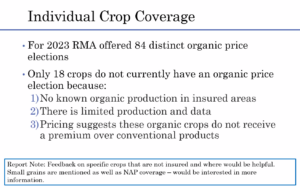
Individual Crop Coverage (slide) Number 2 in this list is the biggest issue and mentioned throughout report – where do we get data and how. People bring it to us, NAP program is where can get coverage up to 65% = not required to be actuarially sound. Producers purchasing NAP – we can’t insure it – but we can go get data there. Sometimes we get data from producer groups. Not a set amount of data need, but do need multiple years, maybe a county, but the more producers can get in an area over several years is more helpful. Also look at proxy crop that yields similarly. In the report one producer mentioned small grains not insurable in area – they should be and if not, we want to look and see where this is happening. Written agreements were mentioned – involves more paperwork, but that is how we expand.
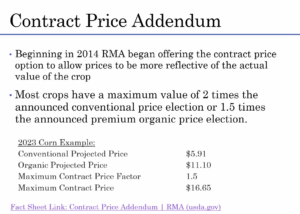
Contract Price Addendum (slide): Brought about to get to a price that is more comparable to what price is for organic. Usually 2 x conventional price (see slide for calculation).
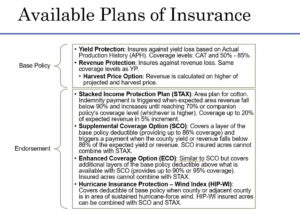
Available Plans of Insurance (slide): Generally 50-80% coverage level – means that if farmer has 70% coverage then 30% deductible. There are various endorsements that help fill deductible and generally area type plans based on the county. Endorsements shown on slide – producer can get up to higher coverage levels.
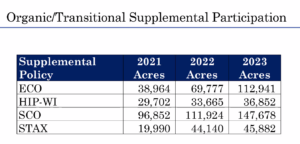
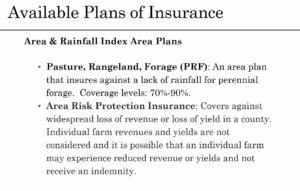
Organic/Transitional (slide): These policies have grown from 2021 – 2023 as shown on slide. This is how producers can get to higher coverage levels. I farm in Oklahoma and it’s expensive.
Available Plans of Insurance (slide): We added Organic and Transitional Practice to PRF. Area plans, instead of individual, you can look at county wide policy, but it doesn’t necessarily follow what happens on your farm. Lots of different options.
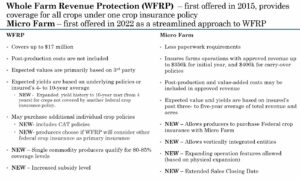
Whole Farm Revenue Protection (slide): First offered in 2015 and microfarm in 2022. Both cover all crops under one insurance policy. IF there is one that is not able to be insured individually, this might be a way. We made a number of new provisions for 2024 and most came from talking to producers and agent feedback. Extended sales closing date- that’s one agents said if had more time said it would help so we extended closing date by 30 days.
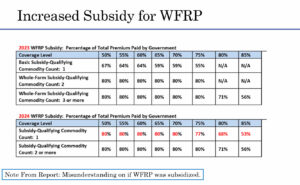
Increased Subsidy for WFRP (slide): Previously if only had one crop that you had whole farm policy – say sweet corn – only crop you had – you were not eligible for 80-85 percent coverage, now you are. We also increased the subsidy level. If 2 or more commodities then subsidy is a little bit higher. Generally for crop insurance program is 62%.
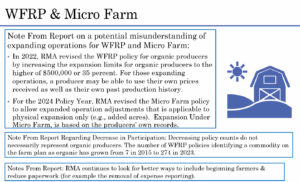
WFRP & Micro Farm (slide): There are expansion provisions in whole and micro farm. The expansion limits based on own production and pricing. Also reference in decreasing participation in whole farm, and in last couple of years when prices so high, dropped out. For organics specifically, there were 7 in 2015 and 274 in 2023 so that part is growing. Hope we can make whole farm more appealing. Agree need to include beginning farmers and ranchers. What do you do about history? A few ideas want to work through. Tried to reduce paperwork too.
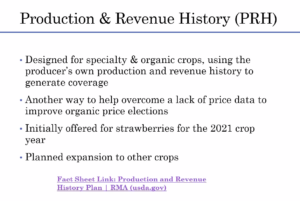
Production & Revenue History (slide): Initially offered for strawberries – looking at other crops now due to demand to expand the program. This is a new pilot. Helpful to get feedback about what works and what doesn’t.
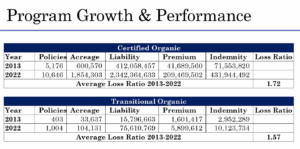
Program Grown & Performance (slide): Number of policies have grown significantly. Report talked about loss ratios and they are not good. You at least for every dollar want a dollar coming back. Shouldn’t be any higher than one. Entire program is looking at loss ratio of one and also required to have reasonable reserve. At about .88 and this is a struggle. Producers talk about T yields being too low and looking at this they are actually too high. If want specifics on loss ratios then go to website. Want to give producers as much info as can.
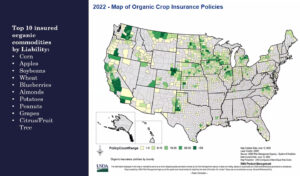
Map of Organic Insurance Policies (slide): Darker the color the more policies there are. Any time have producer does something that works, the more that come on. The more successful organic farms we have the more people will want to get involved.
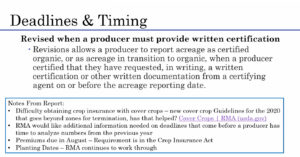
Deadlines & Timing (slide): We revised when producer provided written certification. Now we require you show in writing that you have requested that. Other notes from the report – we would like to hear more about difficulty obtaining insurance for cover crops. Zonal guidelines and published materials for area saying this way cover crops can be terminate or third way have ag expert saying this is a good way to terminate cover crops. This can be brought to agent. Don’t know if this has helped – if get ag expert on a new way for termination – asked how that works, but never seen it done. Also comment about deadlines that come before producer can analyze numbers for previous year. Legislation mandates premiums due in August. Planting dates – regional offices look at this and take data and look at plant dates and indemnities. We need to see planting later and yields going up. We’d like to allow planting dates later. Hopeful there will be something we can do.
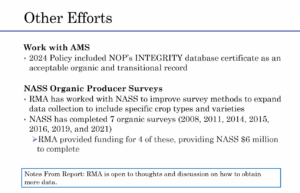
Other Efforts (slide): We will come back. For sake of time, to take a short break [to hear some news from the U.S. Department of Agriculture Under Secretary for Marketing and Regulatory Programs Jenny Lester Moffitt.
Dr. Tucker: [Introduces Jenny Lester Moffitt.]
U.S. Department of Agriculture Under Secretary for Marketing and Regulatory Programs Jenny Lester Moffitt: Vilsack will be announcing the final rule of OLPS. This is a really exciting occasion. This has been a long time coming. Thanks NOSB and leadership, more than a decade and the NOP staff. Exciting time and many in room knows what this means. We are continuing to improve. This is what rulemaking and tenants of OFPA is about. OLPS final rule is another example of that. These rules are part of continuous improvement. Will establish clear standards for Livestock and poultry products. Greater outdoor access for healthcare, transport and slaughter. More consistent standards for outdoor space. Preventive healthcare, transport, handling, making sure all producers are in fair market. Consumer confidence has continued trust with USDA organic seal it means what they think. Implementation timeline, there are many pieces, at most 5 year implementation timeline for furthest. Over 40,000 comments and thanks industry and everyone who provided feedback. Secretary is hopping on press call at 11:00 today. Chair Powell-Palm will be on that call. Exciting day for organic industry, NOSB, NOP. This is about leveling the playing field, making sure we have and maintain rigorous organic seal consumers can trust.
[The presentation returns to the RMA discussion.]
Francie Tollie: We can identify transitional – one of challenges is that I’d like to think everyone in crop insurance program is completely honest – we don’t want to have producer who is out there when input costs so high, saying didn’t apply chemical and get a crop insurance indemnity. IF loss ratios go up, becomes more expensive for everyone. Some other efforts – we have funding last 7 organic survesy with NASS. We provided 6 million dollars for them to complete surveys. Any ideas you have for us to get more data we are open to.
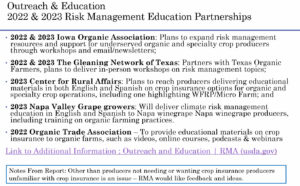
Outreach & Education (slide): I pulled up a few that identified going to work specifically with organic producers. Reasons for not having crop insurance often is don’t know about it. It’s the people that know what’s going that help us move the needle.
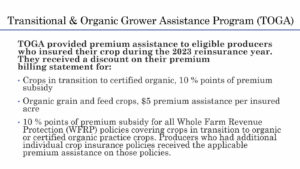
Transitional & Organic Grower Assistance Program (TOGA): offered additional premium assistance – 10% for crops in insurance. Additional information on slide.
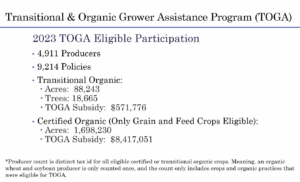
TOGA (slide): some producers have more than one policy.
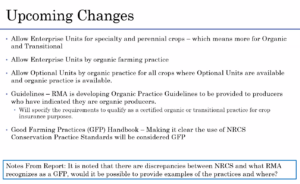
Upcoming Changes (slide): enterprise units way of insuring by pulling all farms together, premium discount so makes crop insurance more affordable. Also looking at enterprise units for organic farming practices and looking at offering more optional unites to tailor to farm. Request for guidelines on how crop insurance works for organic – working on these and going to be asking for feedback. Good Farming Practices Handbook – when we say good farming practice, lets say you are producer and have a claim and loss adjuster says you didn’t follow good farming practice. Producer has right to appeal and say did follow GFP. They provide information about the practice and why did what did. Regional office will decide. When say GFP it isn’t a simple thing, it’s a process. If you have specifics on discrepancies about what is a GFP, let us know, especially if NRCS practice.
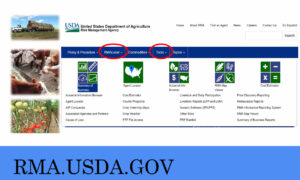
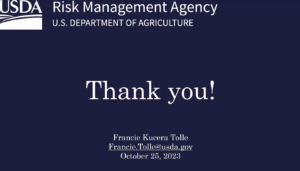
RMA.USDA.GOV (slide): Get to know your regional office – there’s info about t-yields, planting dates, and other tools.
Questions & Answer: NOSB questions about RMA
Dilip: I work with local and regional RMA office in TN and very helpful. You showed a U.S. map with green dots and I notice some states have more and some don’t. What’s the reason and what can be done? The second, can you tell us about vertically integrated entity on microfarm?
Francie T: Map shows where we have organic insurance policies. The darker the green, the darkest have over 50 policies. A lot of reason, if farmer has successful farmers around, and so once get people talking about it and doing it in a way that is successful for producer and organic community, that helps spread. Crop insurance agents – where there are none. If I talked to my agent they would have to research what to do. I want to be able to provide you guys with enough info. IF I were you, I would take to my agent and say this is what I’m looking for and I need your help. Most will try to help you, but it’s an education process for agents. We’ve tried to step up the training for agents. Guidelines I talked about that will be provided to agents and producers is way we’re trying to make clear this is what you need to be doing. This is my speculation.
Dilip: 2 cover crops council and you were asking about more data. I would add these two councils could assist. They can work on this data issue.
Francie T: Microfarm previous to this year, we didn’t allow Vertically integrated entities b/c ensuring up to $350,000. Didn’t want to see large entities break up and apply for microfarm. But then decided there were enough legitimate requests that we did it. We’ll monitor it.
Allison: Heard that in Texas it’s hard to find whole farm policies so if no one offering policy what should they do?
Francie: One, they should be offering it. Some agents are more familiar than others. They all should be, but if someone can’t find someone then contact regional office and see if we can help. Or email me.
Allison: Some slides had acreage, policies, operations participating. Increasing in acreage and operations or how since of how breaks down?
Francie: Whole farm is just one way can insure operation. Program has grown quite a bit. How many of these policies are whole farm versus individual – is that your question?
Allison: more operations taking advantage as acreage growing or similar number of farms but more acreage?
Francie: If I’m growing 2 or 3 different crops then more than 1 policy. One producer might have more than one policy.
Allison: Question about the growth in acreage slide.
Francie: These are supplemental policies. Might have policy for corn, individual policy, might buy 70% coverage. 30% cover yourself. The supplemental policies provide opportunity to fill that gap up to 90-95%. These are not for whole farm, but individual crop policies. If I were guessing I’d say this is going on in Midwest.
Allison: Acres correlate to number of operations?
Francie: don’t have that data. We’ve got various options for transitional and organic farmers. If need for that data, we can pull that for you.
Logan: Why is the loss ratio greater in organic than transitional?
Francie: More losses.
Logan: Saw that loss is higher in organic than transitional.
Francie: You’d have to look at crops and location and don’t’ know right off if same place, weather events, if indemnities based on weather event and where. Have to do deeper dive to see why that is. Ths is the most challenging for us. We don’t want to rip carpet out from under.
Logan: when do you identify when transitional?
Francie: by acreage reporting date, you have to show you have talked to a certifier and in process of doing that.
Logan: things would be like what seed are you planting, etc.
Carolyn: New guidance for crop insurance agents – how are you measuring efficacy of those? Will you give agents a test? How do you know it will be used?
Francie: we’ll be asking them as part of compliance reviews. We have requirements that producer is supposed to be provided.
Carolyn: What is a compliance review?
Francie: 2 different things. RMA has a compliance division. When they go out and look at AIP from agent to producer – they are reporting back findings to RMA and expect them to make changes if procedures and policies not followed. RMA – compliance is about 1/3 of the agency. Regional offices are looking at how things are working. Product management is another 1/3 and we are looking at how going to change things.
Carolyn: You would expect to see more organic crop insurance policies? How measure success?
Francie: Not sure that’s the way to measure success. Better measurement would be to look at partners and see if message is getting out and are people requesting crop insurance. Is survey in study moving needle. Are people more aware of it – get producers familiar with it. Regional offices out there talking to producer groups. Guidelines are not going to be a good measurement.
Carolyn: Thinking about climate events. How will RMA weather that? These problems will become more severe. Do you just take every year as it comes?
Francie: different practices that we look at, different crops, ones that don’t require as much water. Different practices available so those are kind of the things we look at. Still heavily dependent on data. Had pandemic cover crop program – funding only for 2 years. That’s a way for us to collect data to see if different practices are helpful. there’s a lot of little pieces but no silver bullet.
Kim: Can you expand on RMA and NOP collaboration?
Francie: Keeping open dialogue – looking at how we can work together. Best way to describe is to keep in continual contact. Jenny may hear about an issue and want to know what’s going on. Relationship very important.
Kim: Can you go back to slide that shows levels for corn and as talk about transition is there any thought about price factor for transition?
Francie: No, but if you have suggestions we will listen.
Kim: think that is another gap worth noting and gives us something to work on.
Unidentified member: can use contract price addendum. Nice intermediate solution right now.
Nate: losses due to pesticide drift and often misapplications and out of luck with RMA. Also seeing trace amounts in rain water and loss or organic premiums through export. Avenue where can bridge gaps in coverage due to loss of quality?
Francie: not at the moment. One of hardest things to deal with – pesticide drift is one of most difficult things deal with. Even conventional farmers are asking this. Problem is it starts man-made. How do we deal with this? With what you just said are you losing certification or quality?
Nate: both occur. If someone misapplies can usually get indemnity for loss of that year’s crop or up to 3 years if lose certification. But not all states like Washington. Case specific, is it glyphosate or flame retardant, its all across the board and trying to explore ways we could create a national approach b/c state by state is not working. Insurance coverage seems to be the logical tool. Probably is an act of Congress issue at this point. Just curious.
Francie: difficult and different problems with different producers. National approach would be interesting. Different states have different laws. Need some help thinking about this.
Jerry: slide that has U.S. shown b/c it’s way too geographically specific not to give more info than getting. I see 8 geographic clusters that indicate to me crop types. Are there crop types that find this program more beneficial?
Francie: It would be interesting to overlay that. I will tell you conventional farmers that transition are most familiar and first to get crop insurance. Specialty crop producers not as familiar.
Kyla: How to verify transitional claim? ACA did work to create pre-OSP. That tool along with a memo to utilize integrity database – these should address how to verify those producers.
Francie: I hope so too. Memo was several months of work. Also realize more work to do. Would welcome feedback.
Kyla??: quality issue – there are standards for losses in quality, but doesn’t kick in until grade 4 or 5. why we get contracts b/c we get grade 1 or 2 type quality. Could there be a quality metric so it matches contract. There is a purgatory zone where grade 4 starts kicking in for quality. I’ve talk to corn board about this b/c know conventional producers could be in similar situation.
Francie: for food quality for organics, I think we’d be looking for what are those quality levels that we could set in the policy. factor should probably be more regional. When there is a weather event, warehouses or delivery points – quality changes and doesn’t fit national quality. A long time ago if below quality then that’s what would pay. Then elevators started listing insurance and non-insurance price. So where do we get the quality standards. You’re bringing in whole other area – don’t’ know where we get those quality factors. If anybody can help would be great. Big issue. Not the same for everyone. If have ideas we’ll listen.
Compliance, Accreditation, & Certification Subcommittee (CACS)
Amy Bruch, Chairperson
Discussion Document: Organic and Climate-Smart Agriculture: Climate Induced Farming Risk and Crop Insurance
Carolyn: Discussion Document: Going to talk about next steps. RMA is making changes and Francie identified where wants more information. Specific evidence to back up discrepancies. I’ll listen to the transcript. Where do we go from here with this document? I’ m curious what are good next steps.
Allison: A few areas RMA wrestling with. One area that stood out is how to demonstrate producer is in transition that insures not fraud and sounds like some sort of interaction with certifier is what RMA is looking for. Maybe transitioning producers involved in TOPP or buying compliant seed might be other factors that look to. Another was appreciate Francie’s openness to feedback and how can we make that accessible to producers – maybe one point of contact where producers can go to address challenges.
Nate: imagine crop insurance will continue to have challenges. Not going to clear it all up with one document. We could lay foundation for future boards. We can help synthesize conversation for future boards.
Amy heard a lot of comments from producers; invigorating to know we can find solutions. On the short list, I’d like to see if we can advance some of those items, stress test them and push community for solutions that could advance solution oriented outcomes. We labeled 5 or 6 of them. Maybe pick a couple and make progress.
Nate Powell-Palm: how we can be more organized in getting data sets to RMA. Question to community, if any existing infrastructure to get data.
Carolyn: What kind of data would be statistically representative enough for RMA purposes?
Francie: university data, and the more producers the better, multiple years and again if you identify proxy crops we try to work with those as well to get similar data. Not hard and fast rule. Doesn’t need to be federal data, but just well-documented. A producer’s own production and if have delivery point and that delivery point can get data, then that works.
Discussion Document: Opportunities in Organic – Improving Support for Organic Transition
Allison: Transitioning means bringing more land under organic management. The discussion document outlines attention to transition including 300 million investment. TOPP program, direct funding ,and crop insurance discount, and also market development grants. There are barriers to transition noted in document. WE have ability to gather feedback to improve upon what’s already in motion. Asked community 5 categories of questions (see slide). we received thoughtful comments
High level categories are: Role of consumer demand. reducing cost of certification. relationships and trust. getting out of our circles. I would love to hear your thoughts:
Nate Lewis: One of the areas that has come up to me from OTA experience “asking anything” is back to language and what we use. When folks ask questions of certifiers there is a reticence to use certain language to not cross line of “overcoming barriers to achieving certification.” Example: How big does my buffer need to be?” The certifier gave a vague answer. IF we could decide where the line is and share a recommendation that could help certifiers develop that rapport with aspiring and young farmers.
Amy Bruch: Thank you Alison! The commitment from the community came forward. One organization provides price increase for transition producers. There’s not an official transition market, but some companies are willing to invest in transition producers because they want to work with them when they are organic. Walking with that producer the whole way is important. Retention is also something we heard through public comments. Once we gt these producers to transition, we need to also solve challenges current organic producers are facing. Markets and maintaining organic integrity.
Nate Powell-Palm: Trying to be more helpful. I see a world where organic inspectors cut their teeth with 100, maybe 1,000 inspectors and then become consultants and help people get certified. Find a 17 year old who can read, show them how to teach reading, and send them out to spread literacy. We need folks to go out and make it easy so farmers can farm and not be regulatory experts as well.
Carolyn: You triggered in my mind- through my research I found that farmers in transition find the inspector to be a primary source of information. IS it true that the inspector is not allowed to give information?
Nate Powell-Palm: If it’s publicly available information, it’s within bounds. “How should I fill out this form?” Would be overcoming a barrier to certification would be consulting. Filling that gap is the next step.
Alison: I appreciate that point. IT will impact the money is time category. I was reflecting on this yesterday after the TOPP presentation- money to reach and spend time with producers. One on one time or time directly speaking with someone makes a HUGE difference. Someone who had gone through a training was much more likely to be successful. Finding more ways to make people available to producers. Finding them where they are is a really accessible intervention. Providing money to do that in a lot of different venues can have a big impact.
Kyla: Meeting folks where they are and using trusted agencies. Some certifiers do have education and outreach farms, but several don’t, and we’re doing the rule following verification and don’t have the time and resources to meet producers where they are. The other thing is with the mentorship piece with TOPP, is bringing in components not related to organic production practices, but just business plans. Recordkeeping and things that are not as fun but make producers successful.
Wood: The comment on consulting. The cost of certification as a barrier- consulting costs could be a barrier as well. Mentorship is also really interesting because that’s important, but the network effect of building communities of organic growers. What’s better than having the program help get groups of growers together to share ideas as opposed to being a burden. It’s interesting…
Nate Powell-Palm: TOPP actually does exactly that. It pays farmers to be mentors for new farmers. if you are an experienced organic farmer who is busy, but it provides a stipend to facilitate that relationship. Farmer to farmer learning. An inspector with little farming experience can fill out an OSP… but if they had farmer hotline staff- how do I fill out my manure application record. That is implementable without a ton of farming experience.
Franklin: Normally, when you talk with a farmer- about environment and human health. If they ask you what do the financials look like. What is the best material for answering that question. Money they will be making or not making…. environment, health, but at the end of the day they are farming as a business.
Nate Powell-Palm: When we had Undersecretary Moffitt at our farm a couple of weeks ago= what is the special sauce in Montana that we have such a thriving organic community. Price for wheat and buyer is immediately on the table. That’s a community that trusts each other. Trust is the most important part of building out an organization. How you can cooperate and not see it as competition, through formal cooperation or real numbers to trusted advisors like land grant institutions who are building out business models. Real numbers and real costs of production.
Amy: I just want to reiterate the transparency. That was refreshing when I started transitioning. I went to the OID, cold called a farmer and we’re friends to this day. He spent 30 minutes on the phone with me. It’s important to have that network because there are more checks and balances in place. Contract negotiation is something organic producers do more of than a conventional producer. We need to rely on each other.
Carolyn: Research shows you need to make a premium for your organic product if you’re going to be an organic producers. IF farmers are open about their prices, you can’t pit farmer against farmer. There is no price premium on average in the SE.
Jerry: I spent about 6 years of my life trying to find an appropriate home between conventional and organic. I found 0 paths in 6 years that led to any type of premium above conventional. At that point, the consumer had enough on their plate to go between conventional and organic. Today there is more visuals for the consumer to consider. I don’t know how that could be accomplished.
Alison: The point Spencer from WV made yesterday about not having a consumer base nearby that can afford an organic premium. No one should have to pay more than they can afford to have healthy safe food. Affordable and accessible. We have the Organic Certification Cost Share program, it’s not keeping up with costs. We analyzed the 2018 farm bill. One 10th of 1% was dedicated to organic. Organic producers are not asking for special treatment, we just need to get to equitable treatment.
Franklin: I have noticed a number of Extension Agents, the people their farmers are most comfortable with, and a number of seasoned agents have never received any training in organic agriculture. They don’t have the information. We need some re-training of existing, seasoned, very good extension educators. First discussion happens there and if they say don’t do it—we won’t get there because there is a high level of trust.
Nate Powell-Palm: One day every FSA and Extension Agent will have taken the basic IOIA course.
Dilip: Suggests training of trainers and train extension agents.
Nate Powell-Palm: Need trusted organizations, like Farm Bureau who we can show organic is an asset.
Allison: Mentors are important. Finding ways to pay mentees, to consider organic as an option. To attend trainings and come here and meet all of us. People of color and others who don’t already see themselves in this community yet. We can use that to invite people in.
Franklin: TOPP giving financial incentive to mentors as well.
Allison: This was really helpful. Thank you. I will attempt to make sense of this. I hope we can come forward with a proposal for USDA regarding implementing and supporting transition.
Discussion Document: Enforcement: Residue Testing for a Global Supply Chain
Oversight to deter fraud powerpoints- some of these pictures are from our farms. Please enjoy!
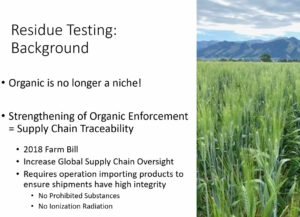
Oversight to deter fraud powerpoints- some of these pictures are from our farms. Please enjoy!
The SOE rule will increase supply chain traceability which is really important. Global oversight will increase. This will require operations importing to ensure high integrity. (No prohibited substances, no ionizing radiation)
This brings us to residue testing. The idea with this DD was to build on top of supply chain traceability to have the verification step as well. Compliance and verification in our regulations. We have listed several points of the regulations where the origins of this document take place.
Jurisdiction: AMS has legal responsibility to ensure NOP has adequate standards, enforcement, and NOSB also has authority to work on residue testing.
Nate Lewis: There is a framework and set of questions to note that testing is a tool for verification that folks are following the rules. We understand organic is a process based standard.
We want to leverage oversight over prohibited substances when possible. We want to ensure organic can remain a leader.
We want to make sure AOAC- accreditation for laboratories- any tests we bring forward are reliable, quantifiable, and widely accepted.
We want to have clear guidelines for responding to results.
Summary of public comments: Testing is not a substitute for process compliance. Heard about need to update NOP handbook – next slide has thoughts around pushing that out and revisiting USDA organic regulations – is there an opportunity to share testing cost burden and how to leverage exclusion from organic markets and give certifiers swift tools to respond to positive results and consider ways to identify where fraud may be occurring. Next steps (slide). Would like board to consider resolution that testing is not a substitute for process. We are seeing a need to propose updates on guidance for testing and responding to positive results. 3 prong approach understanding a resolution is more of a statement to the community. Would be interested to hear from program about guidance – imagine it is a lighter lift than a regulatory change, but just walking into this with eyes wide open. Want to approach regulatory and guidance approaches.
Amy Bruch: Thank you- we want to open it up for discussion:
Dilip: It started with Association of Agricultural Chemists, then Analytical Chemists later.
Kyla: Super excited to get an update, if we can make it happen on those documents in the Program Handbook. They are instructions to certifiers, not guidance, and I think easier to update.
Allison: That was going to be a question for Jenny- so the handbook is best practices, but not formal guidance?
Kyla: There is guidance which is applicable to certified operations- to comply with the regulations. There are other ways to comply with the regulations. If you are doing something different than what’s in the regulations, you might need to show some more information. Instruction is to certifiers and is expected to be followed. IF it’s not being followed, there’s an opportunity during accreditation audits to show how it’s being done that is slightly different, but still compliant. PCO has gotten noncompliance’s for not complying with instructions.
Nate: My understanding is guidance, notice and comment has to occur to follow the APA and the question is related to instruction to certifiers and whether it has same rule that guide updates to instruction documents.
Dr. Tucker: Yes. Handbook. OMB issues new guidance documents. Started to do public comment on guidance but not instructions. At time of import oversight, counsel’s office said we could issue interim instruction but did need to open opportunity for public comment. Basically anything we are going to enforce against, we need opportunity for public, regulating community, to weigh in.
Nate: is it a correct assumption that update to handbook is a smaller lift for standards division.
Dr. Tucker: These days it really depends. In general, right now, guidance and rulemaking are the same lift. Guidance is longer and provides more thinking and context- good tool for super technical content. Instructions are a little faster. We’re going through the handbook right now because some need to be archived because were replaced by SOE. Changes have to go through public comment. It will be an interactive process based on what can be done quickly. We also haven’t updated the Handbook in a while. We have been focused on rules because we can actually really enforce those.
Allison: Thank you. Two follow up questions. The difference between guidance and a rule is that a rule would be binding and guidance is non-binding, but you have to do it anyway.
Dr. Tucker: We see guidance as enforceable. If we issue a “You broke the rule” notice, we cite to the 7 CFR 205. We cite to the regulation. Instructions do the same thing. It points back to the rule. When we are taking enforcement action, that’s what we are enforcing against.
Allison: Do you have a tool to say “this is a best practice” or “it would be good if you all did XYZ” but if you didn’t you wouldn’t be on the road to a Noncompliance.
Dr. Tucker: Using learning center. When it’s a rule you need to follow use words like “must” and “shall.” We are careful in Learning Center that refer to best practices.
Amy: Thanks team for working on this topic! Do you want to proceed to the last item?
Nate: Let’s come back at 2pm and pick up one more CACS agenda item.
LUNCH BREAK
CACS Continued…
Proposal: Oversight improvements to deter fraud: Consistent Location Identification
Amy: Certified Operations Current State (Slide) The goals of proposal are consistency (slide). We heard from community about questions about how it could be deployed and put together an example. “Where is Stacy’s Filed?”
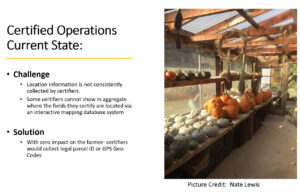
Nate Powell-Palm: When you go see a field, we have done such an incredible job for folks to record and report fields using general and loose language. When I asked this certifier how they would know where field is, they would have to collate 4 different documents to find field. Most of time can’t find on own. Really important farmers can call fields what they want but as you can see (slide) it is so easy to put legal descriptor in one of those columns. The certifier said they received a question from another certifier and trying to describe how to find the field. We need a consistent way to describe fields. Bryan, do you pay property taxes?
Bryan: I do
Nate Powell-Palm: All places require property taxes.
Wood: Yes. Except one territory, Puerto Rico.
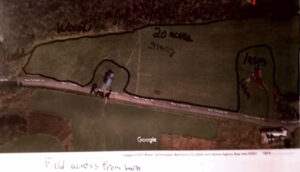
Nate PP: in U.S. we pay property taxes. Every field is going to have a legal description so this is not a big lift folks. Describe property in way to manage the property. This is a field map likely to find in certification file. We see name “Stacy” and direction to field – “filed across from barn” Allison could you find this field? I love how organics has allowed meet where they are and we kind of outgrown that system so we can say where this field is so when someone else has question about this field = how can we o in and know with certify where it is. Big give away, in American not a big lift. In international space, grain exports, will those fields suddenly disappear. So if saying geo codes making big tent, in U.S. will know by property tax codes. In any application can use geo-code. An example of this geo code (slide) – idea of where a field, if zoom out, we can get a good idea of boundaries of the field. Can see road crossings, path, the location of the pin is not that prescriptive, but is another reference point in such a way we can reference it. Right now taking word of producer.
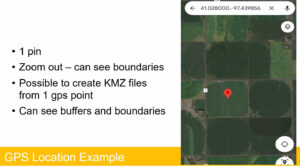
Amy: We did listen to the community. We had two Plain communities join us and asked them parcel number – if that’s a common word, and that was more understandable than the word “field.” Parcel number, street address – land is more developed for a lot of farms, and legal address (township, section, and range). All will lead us to a GPS. We heard from certifiers that said take a point and then make a KMZ file. Once you enter in data can generate reports. When you can aggregate data and manage it will help us understand mass-balance from regional and international standpoint.
Nate Powell-Palm: An example, if we can record these fields and enter crop. Say corn this year and certifiers can marry up acreage and crop they are able to understand capacity of portfolio of clients. If suddenly see receipts that exceed then can look into that. That’s doable by a lot of certifiers. This is not new to anybody but it is inconsistent across the world.
Amy: Benchmarking with other countries. Mexican system requires GPS coordinates. Certifiers – believe OneCert requires GPS for international operations. This is where industry is morphing and we do recognize diversity in community. Several means of getting to end result.
Nate Powell-Palm: goal is for certifiers to obtain information, Geo codes being one way. How do we make sure grain being produced is legitimate. This is low hanging fruit.
Amy: Like to call it basic conditions. Foundation that will solidify given industry is growing. Want to understand the impact of what we are proposing Key to some confusion: key to geo-codes is meant to be an example but not exhaustive list? [Yes.] And the feedback list is more examples? We may need a copy editing fix here. An “EG” or something in the parenthetical. Pulling from discussion on guidance: NOP would have to go through public comment and it would essentially be binding.
NPP: Interesting re: comments. There is nowhere in OFPA that’s the basis for this rule. It’s a conversations starter. This is not something that is going to be a condition of accreditation – nothing that would lose a certifiers’ accreditation.
Allison: What I took away from our conversation is that by issuing guidance, it could put accreditation at risk?
Dr. Tucker: It could put at risk. I would like to look through the light of capabilities of requirements in OID. We would want to take a look at most expedient and reasonable response to this type of recommendation. I think we’d have to look at in terms of guidance and building on capabilities that may already exist. Will have to take a look at that.
Kyla: I have had the opportunity to have lots of conversations on this topic. Do think that we heard through comments that there are East-West differences in how we talk about land. That is coming through. Saying field, you mean “parcel”… We heard that in the East there is more often a physical address that goes with land versus the West. That seems like viable option here. Just to be clear that this was helpful for me not being a farmer, so I don’t think about these distinctions as much. A parcel number could be used for more than one “field” so on that chart of examples, they could all have the same parcel number associated with them. Unique identifiers are to parcels, not to fields. So you are getting in general location – spitting distance – using that code.
Nate Powell-Palm: Goal is to get within earshot of where producing these products. The legal boundary does not change unless subdivision.
Dr. Tucker: Apparently in OID, we take addresses provided by Certifiers and we use an external service to transfer them to geo-codes. We have to think about whether wed expose information. Realities on this one are policy and tech solution.
Carolyn: I find this whole conversation simple but confusing. Nate have you thought of unintended consequences based on what you are proposing?
Nate Powell-Palm: Of the 3000 inspection I’ve done, about half on Amish farms. I’m confident that the onus is on certifiers. When I look to certifiers who’ve already done this, the certifiers who represent more than ½ certified operations, we know it’s going well. E-cert is a database some certifiers use and it includes place where geocodes can be entered. Inspectors said this would be a big help in terms of making their life easier. Zero burden on operation, it’s on the certifier.
Allison: One scenario is using this for mass-balance. I see that’s where a problem would come up. Can you walk through how this helps solve mass-balance problem. And what if things moved around on a particular farm and not matching info?
Nate Powell-Palm: with the location information we are going back to a legal parcel. Through state interactive mapping system, we can check if we need to. If somebody says producing heck of lot of wheat can look to see if accurate. For the mass-balance, right now focus on tiny mass-balance on single crop for whole year. Bushels/acre. I see it as a certifier being able to hear, this county is producing a lot and not a way to go in now to check it out.
Dilip: Similar question. One example of a 500 acre farm growing multiple crops. Is it going to be in the records how the crops are split up in the acres, including multiple crops.
NPP: Clarifying that that 500 acres could be a single land parcel. We are really just looking at getting to that 500 acres. Internally lots of other OSP questions we would ask. Right now we don’t have a consistent way to get to that 500 acres [and that’s what this is trying to solve].
Allison: Three amendments to language to offer. First, to consider saying NOP advise accredit certifiers so NOP can look at OFPA and implications with certifiers and choose the right tool so there aren’t accuracy repercussions. Second, “to obtain” wondering if we want to say “to record” – language to show intended certifier do work. As for geo-codes, to make it known that there are the other acceptable forms of location identification.
NPP: Are they substantive changes.
Allison: Clarifying amendments.
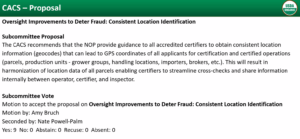
Amendments accepted by motioned and seconder (NPP)
Jerry: as you would do anyway, can you say which way votes go.
NPP: a yes is a yes
- Vote: 13 yes, 0 no, 2 absent. Motion passes.
Development Subcommittee (PDS)
Allison Johnson, Chairperson
Verbal Update: PPM Updates
Allison: We don’t have anything to discuss or vote on today, but we are working on a PPM update for the spring. We are trying to set NOSB up for success, and expectations are clear. After operating through COVID-times, we are having updated clarity for when meetings can be missed. Updates on training and communication of non-unanimous proposals.
Separate from PPM working on how NOSB can engage in Equity Commission.
Nate Powell-Palm: It seems we are having some fantastic discussions outside national list and would be so stoked that if a material is unanimous coming out of subcommittee then we can vote on slate.
Carolyn: I like the idea, but in addition to unanimous we’d want to make sure no strong public comments to consider.
Wood: Supportive and like what Carolyn is suggesting. Frees up time in the meetings to have more conversations about the future of organic. Very important.
Kim: On same token, suggest some kind of language around new items. Each of the NOSB members have time to review consent agenda.
Crops Subcommittee (CS)
Amy Bruch, Chairperson
Amy: Our TR process: when we do review them we try to get them reviewed quicker so they are available to stakeholders as soon as they can be. We have one proposal to start off with and then National List items after that.
Proposal: Potassium sorbate (KS) – petitioned
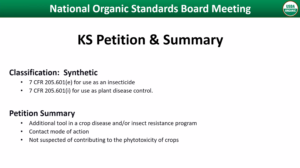
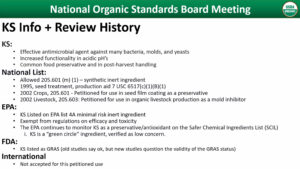
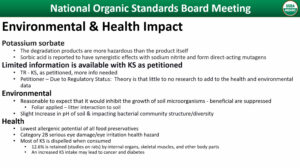
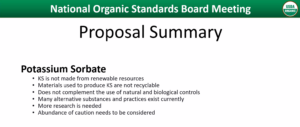
Amy: Few slides to walk through and couple of comments. Petitioned for 2 uses (1) insecticide and (2) disease control. The main method of effectiveness is contact, no residual with this product. Currently allowed on NL as synthetic inert ingredient so is in some products used by organic producers currently. FDA lists it as GRAS. Internationally not accepted for this particular use. Environmental and Health impact (slide). Information really relates to it as a food preservative. Petitioner provided additional information. One thing notable is that this product will have minimal soil interaction. Some comments with its subproducts when it breaks down, degradation more hazardous than product itself. Reads slide of proposal summary. There are cultural practices to mitigate substances. Petitioner responded that it could be to used to reduce dependence on copper and sulfur. Did not show they were testing KS versus copper or sulfur but interesting to know it could be used as substitute. Petitioner doesn’t anticipate more information about environmental or health impacts.
Public comments for this substance: We had 7 written comments and 2 oral. 2 activist groups. One advocacy, etc. Said no. Some grower groups were in support, but noted they did not have a push from farmers to support this because they didn’t see the farmers needing it. One grower group said yes just to use as insecticide and another said yes to both uses. Growers said it targets powdery mildew, and that was the main benefit groups said “yes” to it. As an insecticide, many said it’s action wasn’t strong enough to be useful. Anything you want to add before we open it up?
Logan: Looking at from petitioner, we did not see sulfur or copper to compare with. Performed better than potassium bicarbonate. Not getting soil contact that would inhibit microbes. Hard to say better alternative.
- Vote to classify Potassium sorbate as synthetic: 13 yes, 0 no, 2 absent. Motion passes.
- Motion to add Potassium sorbate to the National List at Section 205.601(e): 0 yes, 13 no, 2 absent. Motion fails.
- Motion to add Potassium sorbate to the National List at Section 205.601(i): 0 yes, 13 no, 2 absent. Motion fails.
2025 Crops Sunset Reviews
Alcohols: Ethanol and Isopropanol
Logan: Used as sanitizers and disinfectants. Widely accepted internationally. Considered nontoxic and biodegradable. Broad support in written comments in spring and fall. Cost-effective, easy to get in rural areas. Commenter said they value b/c generally available when needed.
- Motion to remove Ethanol from National List. Yes: 0 No: 13 Absent: 2. Motion fails.
- Motion to remove Isopropanol from the National List. Yes: 0 No: 13 Absent: 2. Motion fails.
Sodium carbonate peroxyhydrate
Franklin (presenting for Mindee): Used as an algicide, disinfectant and sanitizer. Environmental issues: there are emission issues during production. It can have negative impacts on fish and non-target issues, depends on when it is sprayed. CS discussed it. Commenters said that breakdown products (water and O2) are more beneficial than copper products and fewer corrosion issues. Some commenters said is not being used like it should, and other said it is way better than copper sulfate. CS considers it compliant with organic requirements.
Nate: Was there discussion about the annotation. I don’t like the annotation b/c seems to apply to every pesticide.
Amy: I don’t think we tackled how broad the annotation is but think that’s good to put in the record.
- Motion to remove Sodium carbonate peroxyhydrate from the National List. Yes: 0 No: 13 Absent: 2. Motion fails.
Newspaper or other recycled paper, without glossy or colored inks
Amy: Two listings for this material, we will be discussing and voting on them together.
Wood: have well known material. Think biggest issue is that the listing is glossy or colored inks and difficult to manage around these issues in a number of different contexts. The newspaper is breaking down and degrading into soil. On compost side the use of this material is compost feedstock is that given that municipal compost is allowed and could include some of these inks it because difficult issue to understand how this gets managed. Comments recognized that listing that just focuses on glossy and colored and not material in glossy and colored inks raises some issues. We had a healthy discussion bout this in the spring. Feedback from community is pretty clear – heard from number of organizations – in general, that there is support or no opposition to relisting of material. There were some careful reads of prior TR from 2017. There has been a call for a supplemental TR in the future, but no opposition to relisting the material. Want to be clear that some supported continuing to relist and some did not oppose relisting. There was general feedback from certifiers that members are listing this in OSPs and we’d asked some questions about annotationg differently and no feedback about updating it today. A lot of focus on supporting small scale growers who rely on this material.
Brian: think that issues wioth paper and recycled paper goes farther than what’s in the inks. Now I believe there are plasticized paper I get in the mail – concerned about the materials that can be in them. Back in the day, when this was originally put on the list it was allowed in organic systems newspaper was a different thing back then. I would like is to hold the possibility up of adding an annotation to this to deal with the phalates and other things in the paper. And address plasticized paper. Wanted to put that out there. Another question: does this include cardboard? [Yes.]
Amy: With compost on our work agenda, this is another route to address these issues.
- Motion to remove Newspaper or other recycled paper, without glossy or colored inks from the National List. Yes: 0 No: 13 Absent: 2. Motion fails.
- Motion to remove Newspaper or other recycled paper, without glossy or colored inks (as compost feedstocks) from the National List. Yes: 0 No: 12 Abstain: 1 Absent: 2. Motion fails.
Plastic mulch and covers
Logan: Also listed in OFPA that it is prohibited unless it is removed at end of growing season. Used as herbicides, weed barriers. Other functions include warming soil, soil retention, etc. High value crop use plastic. Many commenters stated current essentiality with concerns. Desire to move away from disposable plastic products while maintaining the listing for now. Two listings for plastics mulches, one normal one and one for bio-based mulches. Environmental concerns: soil and water contamination, limitations to rrecycling concern of microplastics. One commentor stated this is lose-lose, where delisting is serious consequence but it is bad for the environment. Concern for PFAS and phalates leaching. 100s to thousands “duplicated comments” concerned about these leaching chemicals and plastic. The comments also anted to phase out all use of the PFAS and other chemicals. One person showed PFAS chemicals in organic kale: was not significant difference between organic and convectional kale, but a huge difference in whether the kale was packaged or not.
Alternatives likely would be needed for each function. Biodegradable mulch would achieve many of these. Organic no-till are in scope of research. Another commentor said would like industry to look at other cultivation practices.
Many of the crops listed are subject to easy damage, have vining habits, or trellised. Other international standards have similar annotations for mulch or have bio-degradable mulch. The CS feeling is similar to many commentors. Grower and grower groups were in support. Zero consumers were in support.
Brian: Want to repeat what I said on newspaper one. Hope can use annotation process to start a giant wheel to address big environmental problem.
Carolyn: kind of funny that Logan when summarize growers supporting and consumers not. I can buy the plastic but farmer can’t use it on the farm? I think we should also stop thinking about recycling as a solution.
Logan: Skipped over one comments about PFAS and kale: it just encouraged consumers to buy loose-leaf kale is that was a concern.
Wood: hard to separate from biodegradable mulch issue. I’d rather see the problem than hide or biodegrade the problem. Let’s face problem as a community. This is a big issue we should be wrestling with. A number of comments reflected that.
Amy: I like the question that was added to learn about alternatives. It did push people to think of alternatives outside of bio-degradable mulch. Weeds in-row as a universal problem. Universally a problem in organic. Logan you currently crow in challenging environment in the South and I don’t believe you use plastic.
Logan: We don’t use plastics. We have variety of vegetables, including kale. Kales onions carrots. We don’t grown tomatoes or eggplants or strawberries. We do grow some of crops some folks grow on plastic. You’re right the weeds are a problem. We grow corn too. We throw 4,5,6 inches of dirt to bury in-row weeds. Corn is pretty resilient so can handle that. Same thing with soybeans. A lot of veg crops are more sensitive and soil born diseases. WE grow some veg crops and spend a lot on hand weeding. H2-A labor for hand harvesting and weed when necessary.
Amy: Didn’t see too many comments mentioning this: ton of innovation. We’ve done fractional movement of dirt, propane flamers… expensive right now, but used to handle weeds. Strawberry growers mentioned that plastic helped with fungus. The irrigation systems is also a challenge in these areas, like emitters, is hard to combine with tillage.
Logan: Laser weeder is exciting but cost is about 1.5 million. We do use propane burning and wouldn’t be able to use with plastic mulch. Use it for sterile seed bed. It can significantly reduce weeds. It has to be whole strategy. The plastic mulch there is entire season. Other methods require multiple steps.
Allison: Wresting with “true cost of food” idea. As long as plastic mulch is available to someone, it’s going to be hard to encourage someone else to take that step to use something else. I hope our community is taking a hard look and will tear off band aid soon. Hope this moves to coming off the list soon.
Kyla: My concern about what Allison and Carolyn brought up, plastic mulch is the only place we really see plastic on the National List. I guess I’m concerned that of the fairness if we annotate then all is falling on one sector of plastic usage. Does not cover packaging, drip tape, transplant containers, and all the other uses of plastic so it feels like. If we delist it and it’s prevalent, going to be interesting conversation. There’s this one listing and a lot of plastic not covered by this listing.
Jerry: Where I have my problem, and I thought between Allison and Kyla it would get said: after agonizing over this for a full semester. We are not the people to do this. Organic world is not the group who can do anything to more this needle. If we penalize the organic community to take this away from them, it would cost. And if we do that we take it away from our growers it’s still going to be available in 90% of the conventional world. We will have no strength to address the manufacture. The devil is the good side of plastic: all is absolutely true.
Logan: going to be significant to organic growers and other international farmers are using it too. More than likely we’d disadvantage domestic growers and still receive product from international growers that use plastic.
Jerry: Saw plastic mulches on farms in France and Germany this summer. You’re right; they wrestle with it in other ways. They use it into 2nd and 3rd year, which is a lot of work too. Product that is both evil and highly functional.
Dulip: Complex issue. I also understand we have come a long way since 2001 and now in 2023 – until have 100% biodegradable mulches this will be complex.
Kim: On the justification for the vote – removing plastic covers would also remove PVC-based mulch?
Logan: That’s my understanding. The restriction for PVC is not there.
Kim: I saw during subcommittee there were some abstentions. If everyone were to abstain what happens? Does that then reduce the 2/3rd vote. [Abstention is more equivalent to an absence.] This is where the community wants a “plastic reduction pledge”… maybe there is an offset in some from. Maybe that’s the challenge. Like the state of CO has removed plastic bags entirely. If we reiterate it’s a state of mind, what do we do? How do we start tracking those offsets?
Frankin: Agree that use of plastics is important and farmers need it. It just isn’t consistent with our image as stewards of environment. How can we incentivize those conducting research b/c farmers will always need something for weed suppression?
Logan: There is research with biodegradable mulch, but it almost has to be proposed research that includes all of the functions that plastic mulch does. There’s a lot of thinks that needs to be inclusive for all of them to incentivize grower.
Franklin: The bio-based – whatever % we get to – biobased really has to work for farmer. There has to be a direction where we wean farmers off these products.
Logan: Some people really want to go toward bio-based mulch.
Nate Powell-Palm: would like to note how important small vegetable grower voice is on the Board and not having it is damaging. Just want that on the record.
Brian: Put out there that personally I am not in favor of taking it off the list now. Even though orgnaic is small % of all plastic much use, we can lead the way here. There could be other incentives and pushes to put us in the right direction here. In our stakeholder community we need the best thoughts. Where is the requirement for removing the mulch at the end of the growing season?
Logan: 205.206 and under OFPA
Nate Powell-Palm: In pest control section.
Nate: Evaluate the potential for a hierarchy for weed control. Like when other cultural practices are not enough. Building that into weed management might be a step forward. We see with PVC restriction: we can restrict TYPE of materials, so if we can get more info about PFAS we could consider expanding that list of annotations.
Jerry: I can go home and have wife say stubborn old man. I want to run this by the team. I think we should go find the EPA and tell them what should be done. The strength to move this needle is not going to come from 3 percent of the plastic on the ground.
Wood: Responding to Franklin asking about research priorities. I hate this material, I hate and don’t believe there is no recycling for this material but I refuse to kill organic with this vote.
Nate Powell-Palm: in triangulation between Kim’s point I want to elevate what Carolyn said. this feels like a cheep shot that its’s easiest to blame the farmer. uproar over plastic bags around the country. To jerry’s point, we’re never going to make a dent with this. It’s a virtue signal if we delist this. I would say plastic sucks, but sometimes necessary. How do we take to heart TOPP and now you’re going to have one major hammer not in your tool box, then we are aiming for the wrong target. Challenge us to look to Expo West and tell me about plastic and go to those CBG companies and say “no more.” To challenge ourselves to think, if going to pick a fight, pick it with the big guy. Don’t go after the farmer. We hear a lot about helping medium and small size farmers.
Logan: Labor is an issue for smaller growers and weeding needs to be done timely.
Nate Powell-Palm: When think to resources of small farms, they often have 1 employee and that’s the farmer. Are we having an effect or are we signaling and is it worth putting those folks out of business.
Franklin: Yes, small scale folks labor is a major issue. All the advantages are important. We se the advantages, but we need to think of what to do in the future. What can we do to accelerate that process away from plastics?
Nate Powell-Palm: We saw around 24mil in OERI grants granted. We should start to cultivate relationships with research folks and have them in the room to hear these conversations. Surprised how few of our research proposals end up in research.
Amy: I think it’s a full court press. Challenges make you think. I think outreach to private sector is important. As Jerry mentioned, it’s all sectors. Plastic is in a lot of forms, Nate circulated a report and baling twine was more prolific. This is an issue for all hand on deck.
Dilip: I know researchers, I can see if they have updates.
Carolyn: Thinking that if there was a bigger dent at reducing plastic at consumer level – use it where it’s the most benefit — don’t focus on farmer level.
- Vote: Motion to remove plastic mulch and covers from the National List. Yes: 1 (Allison) No: 12 Abstain: 0 Absent: 2. Motion fails.
Aqueous potassium silicate
2 uses (1) insecticide and (2) plant disease control
Brian: Effective fungicide and miticide. Used by hundreds of organic farmers. TR very low environmental impact. Nontoxic to birds, fish, and bees. Stuff is a slam dunk, right? We go deeper than EPA and FDA. Concerns – in the past people have said negative effect on farm workers, produce quality and whether essential tool. We requested new TR last year and will respond to concerns. New TR allayed a lot of concerns that I could ferret out about toxicity of this product to application. 2015 TR review noted skin irritation at higher than normal concentrations. Aggregate exposure risks rated as negligible. As far as produce quality concerns, basically those were based on research done on this kind of a product and done with nutrient solutions that deformed plants – wasn’t relevant to kind of uses we’re talking about. In my mind, the crops committee agreed with me, for written comments 3 in favor of relisting , 1 for disease only, and one opposed both. 230 listings for farmers on OSPs. One noted incidental nanoparticles and did not cause concern in two TRs. Overall, that it presents environmentally benign and can reduce reliance on sulfur and copper.
Logan: Comment: we use this product. Looking at it mode of action seems to make it harder to chew and digest. Is that the mode?
Brian: the comment about more difficult to digest for forages – that was a study with different levels of soil fertility and lower yields. Higher level of silicates – again it had nothing to do with application of this. Unfortunate that TR brought up these issues without looking more closely. I went through and read articles, they were not on target, in my opinion. Just to follow up – the mode of action of potassium silicate does involve getting into layer between epidermis and internal cells, but it’s a tiny amount. No effect on fruit quality.
- Vote: Motion to remove Aqueous potassium silicate from National List. Yes: 0 No: 13 Absent: 2. Motion fails.
- Vote: Motion to remove Aqueous potassium silicate from the National List. Yes: 0 No: 13 Absent: 2. Motion fails.
Elemental sulfur
Amy: Used as insecticide, plant disease control, and soil amendment. Benign in environmental sense, has some human health impacts (irritants mainly). NOSB reviewed journal articles that OSU researched effects on children’s respiratory health. Historically strong support, especially for the listed uses. included on original National List since 1995. Alternatives are not as effective. There are concerns we want addressed by inerts working group. During the review the NOP said the inerts issue could be a technical correction, All commenters were in support but their were concerns. For insects, backbone of pest management (kills them if they touch or eat); as fungicide used to control many diseases including powdery mildew. Kills on contact. As soil amendment, soil can be deficient. Sulfur is moveable in soil, need to test soil. One soil amendment that is not annotated that soil samples need to be provided to justify use. Concerns surrounding ways that sulfur is derived, like scrubbers. Concerns about using fossil fuels and heavy metal contamination. Other commenters said some of these concerns could be alleviated by certain procedures. Others said little to know alternatives available.
Did ask previously and did see comments, dry versus wet application. We learned from community that both forms are needed. Different efficacies and different timing.
Allison: The worker issues raised her and worth taking quite seriously. I had opportunity to interview former farmworker who encountered health issues, including inflamed hands and body, and she realized it was on-farm exposure. She asked what she had been touching and it was sulfur. Labels are not always followed, and if not providing workers with adequate protections, is not enough. We need to take up considering annotation.
Brian: Address the issue that often comes up: effect of repeated applications of sulfur on soil. In my 20-year orchard, was heavily reliant on sulfur fungicide. It dropped the Ph of the soil which caused calcium deficiency, which spiraled out of control, causing bitter pit. That issue is part of the risk.
Amy: Good point, this doesn’t require soil test but does affect PH over time.
Brian: Soil can be remediated over time with lime.
- Vote: Motion to remove Elemental Sulfur from the National list at section 205.601(e) as an insecticide. Yes: 0 No: 13 Abstain: 0 Absent: 2. Motion fails.
- Vote: Motion to remove Elemental Sulfur from the National list at section 205.601(i) as an plant disease control. Yes: 0 No: 13 Abstain: 0 Absent: 2. Motion fails.
- Vote: Motion to remove Elemental Sulfur from the National list at section 205.601(j) as a soil amendment. Yes: 0 No: 13 Abstain: 0 Absent: 2. Motion fails.
Lime sulfur
Brian: Really activity different than sulfur. As mentioned previously, sulfur is acidic. Lime sulfur is more alkaline. It is widely used by organic farmers. Caustic in concentrated form so applicators and mixers have to be careful before dilution. Don’t want to touch eyes. Can be hard on beneficials and one of main concerns, but that issue has been well known for 50-60 years. Well-defined for fruit growers and very easy to time so don’t’ crash beneficial populations. Different than sulfur, b/c it has kick-back effect. Fungal infection can be underway into plant leaves, but lime sulfur will have a curative effect whereas almost all other fungicides have to be in place before infection occurs. Can be important for weather reasons. It’s relatively non-persistent. Get 5 days protection from a spray and washes off quickly. 9 comments in favor or relisting, one for insecticide only, and one was not clear but wanted annotation for no impact on beneficial populations. 280 farms listed it on OSPs.
Nate: It is essential for fire blight control. Fewer infection sites when comes to an orchard. Just noting cited by board as reason not to renew antibiotics for tree fruit. Important in Washington state.
Brian: Lime sulfur has that effect, sulfur does not. Important tool.
- Vote: Motion to remove Lime Sulfur from the National list at section 205.601(e) as insecticide. Yes: 0 No: 13 Abstain: 0 Absent: 2. Motion fails.
- Vote: Motion to remove Elemental Sulfur from the National list at section 205.601(i)(6) as plant disease control. Yes: 0 No: 13 Abstain: 0 Absent: 2. Motion fails.
Hydrated lime
Franklin: It cannot be used to cauterize alterations. Environmental: said to be slightly toxic to aquatic life, when large volumes are releases, they can increase Ph of soft bodied creatures, but bacteria can adjust. Public comments: most endorsed product for disease control. One comment said it should be used specific for disease control and annotated for specific use. Generally CS discussed issue of environmental issues but agreed it needed to be maintained on the List.
Kim: Hydrated lime is material we see across spectrum of subcommittees.
- Vote: Motion to remove Hydrated Lime from the National list at section 205.601(i)(4) as plant disease control. Yes: 0 No: 13 Abstain: 0 Absent: 2. Motion fails.
Liquid fish products
Amy: NOP stated at 2023 meeting that the recommendation regarding annotation was on hold. We got a lot of feedback from community. Technical complexity makes rulemaking problematic so NOP does not plan to move forward on this item.
Tucker: Touched on this a bit in NOC earlier this week. This is on hold. It is important for us to provide clarity and say it’s open — but in this case, we have closed it. Few challenges: marine environments are difficult due to multiple reasons. Shared jurisdiction with NOAA; complexity of dealing with another federal agency. There wasn’t clear consensus on this. Public comments were quite mixed. We tend to move forward on things with consensus. Third, need to keep certifiers in mind. Their job is already difficult: some of the criteria they would need to apply to these materials is difficult. I warn you all to think of certifiers when thinking of annotations. This recommendation would be a big burden on certifiers. We’ve completed the triple crown of rulemaking this morning. We’ve focused so we could say yes on the really important things.
Allison: Appreciate explanation – the piece about lack of consensus in community concerns me. What is the role of the board then – think we look at divergent opinions and come to recommendations – my question is what is your recommendation when divergent opinions in community?
Tucker: We don’t need complete agreement, but this one there were concerns. We shared some of the concerns and it was known by the NOSB at the time that these were concerns. Feedback from community says its controversial, you often send it back for discussion. Each item needs to be taken case by case. The statutory authority one is a big issue. We did not finish aquaculture. Marine environments are very different and would work up a whole new regulatory question.
Wood: understand that and also feel that even if result of process would have lead to focusing on invasives, for example. To me there is an opportunity for leadership from organic. I appreciate the process, but I do think when opportunities to build bridges to other agencies, I think that’s an opportunity and hate to see it dismissed like that.
Dr. Tucker: I think we remain aware of importance held by many people on this. For right now, I think our closed determination is the right decision, but maybe in the future things open up for different reasons. The timing could get right.
Amy: Comment summary: 10 written comments we received. Over half of them mentioned importance of the annotation. Two advocacy groups said they would not support the product if the annotation was not approved. One certifier said over 1100 members list this product on their OSP. Crops it’s used to deliver nitrogen and is important. Additional concerns about this product: even if fish does not have a commercial value it may have an ecological value. The use of discarded fish parts as fertilizer could remove nutrients from marine ecosystems and there is a concern about PFAS contamination. One commenter wanted an even more restricted annotation from what was recommended. We talked about supplementation as well: the Cs did dive into that further with OMRI. One commenter noted concerns about fortification with prosperous – CS found that phosphoric acid is used as the stabilizer about half the time.
- Vote: Motion to remove Liquid Fish Products from the National list at section 205.601(j)(8) as plant disease control. Yes: 1 No: 11 Abstain: 1 (Wood) Absent: 2. Motion fails.
Sulfurous acid
Jerry: Primary use is an acidifying agent in soil and or water. Discussed in spring 2023 meeting. Review is supported by TR which largely focused on essentiality. 14 comments, nearly all written, and nearly all in support of continued use. Strongest comment against notes it could mask poor soil conditions or practices. Subcommittee is not proposing removal.
Nate: Necessary for Washington stakeholder I represent. We are number one in blueberries and need to acidify irrigation water with this substance.
Amy: Comment – I was hoping there would be alternatives, but in commenters it acidifies and reduces impurities, so it reduces ability to have pure alternatives.
- Motion to remove Sulfurous acid from the National list at section 205.601(j)(11) as plant or soil amendments. Yes: No: 13 Abstain: 0 Absent: 2. Motion fails.
Ethylene gas
Logan: Primary use is for inducing flowering in pineapple. We didn’t hear any oral comments, but some written comments including DOLE saying they do not use it to ripen but to induce flowering. Have not found an alternative and depend entirely on it for that purpose. This product is applied between 7-15 months. Pineapples have staggered flowering which limits the ability to harvest efficiently or economically. In 2015 growers said the de-listing would make people go to conventional. Being able to have this product have a lot of small growers be able to make a living. The substance has no alternative. Environmental issues: from TR the toxic release inventory is 18mil pounds. Not clear how much is coming from agriculture. Human health: highly flammable, explosive, and causes some human reactions limited to work area. Total of 9 comments from written comments. Grower group said that ethylene is necessary. Also accepted in international standards.
Jerry: Fails to say the purpose, the end result is it’s a labor saving initiative.
Logan: It actually reduces quality issues because it’s hard to tell if pineapple close to maturity. Increases quality.
Allison: Subcommittee vote was not unanimous. Could you speak to nonunanimous?
Logan: Mindee was concerned in her work had come across poor quality, off-season pineapples. Not used once have flowering, just trying to time that. I don’t know how to state whether out of season or not.
Nate Lewis: Labor saving: somewhat accurate, but there is a worker safety issue. It’s dangerous to harvest pineapples and the fewer times you have to go through fields is important. The OPW showed what the pineapple leaves look like… you want to limit exposure.
Dulip; This is about inducing flowering, not as a ripening agent – subcommittee looked into this as food ripening?
Logan: A lot more uses for this product post-harvest, even preventing potatoes from sprouting.
- Motion to remove Ethylene Gas from the National list at section 205.601(k)(1) as plant growth regulator. Yes: No: 13 Abstain: 0 Absent: 2. Motion fails.
Microcrystalline cheesewax
Jerry: I happen to like this sunset. First time can talk about being grower without using the “h” word. Grew it for about 6 years in Virginia. Comfortable with what sunset says. The bulk of conversation dealt with current need. It was noted that method was widely used by small producers. Spring 2023 session, 10 written comments – none against it. One commentator expressed support until non-petroleum alternative identified. Continues to be widely used by small shitake growers. Subcommittee finds it compliant and does not propose removal.
- Motion to remove Microcrystalline cheesewax from the National list at section 205.601(o)(1) as production aids. Yes: 0 No: 13 Abstain: 0 Absent: 2. Motion fails.
Potassium chloride
Wood: Helps get potassium to plants but it can accumulate in the soil. If it is used it has to be monitored to ensure the soil salinity isn’t effected. We’ve had good discussions and a TR on this. We continue to see strong support from community for the way this is listed. We had 11 comments in support of continued restriction. One group mentioned it is on the EPA list 4 and SAFER list. Certifiers mentioned they have significant use of this material with this restriction in their OSP. It is being used. One certifier noted it is growing in use. One comment was interesting: greater consistency is needed to determine that it’s not accumulating. They accept OSPs as “techniques” that limit soil accumulation rather than soil tests.
- Motion to remove Potassium Chloride from the National list at section 205.602(e). Yes: 0 No: 13 Abstain: 0 Absent: 2. Motion fails
END DAY 2 FALL 2023 NOSB MEETING
Thursday, October 26, 2023: Fall NOSB Meeting, Day 3
Handling Subcommittee (HS)
Kyla Smith, Chairperson
More information on the petitioned substances and Sunset Reviews can be found in the Fall 2023 meeting materials.
Discussion Document: Magnesium carbonate – petitioned
Kyla: Petitioned use and addition of magnesium carbonate as a processing aid to the National List at 7 CFR 205.605: Nonagricultural (non-organic) substances allowed as ingredients in or on processed products labeled as “organic” or “made with organic (specified ingredients or food group(s)).”
We are waiting for the TR. We are going to talk about them collectively as they have the same use and same way – they are used interchangeable and not together.
Petitioner stated that during the final steps of itemization that the chickery sticks to walls and reduces rate of production. Has a bit of history with National List for use with agricultural products and prohibited in ag products labeled as organic. Voted to remove from NL. Effective Aug, 7 2017. In 2005, it was petitioned as filtering aid and it was rejected by NOP b/c it was incomplete and b/c not agricultural. Only 3 public comments. Most said needed to wait until TR complete. Two commentors did state that we should stick to petitioned use and limit only for organic chickery production. One commentor stated they did a preliminary review and no hazards revealed, but wanted to evaluate TR. Handling committee received TR at end of August. I haven’t taken a deep dive into TR yet.
Franklin: Do we have info on whether they use nanotechnology?
Kyla: Nanotech is prohibited. Hopefully we will get more information on that in the TR. That was a comment made by the petitioner. I do not know if there is anything to those claims.
Discussion Document: Magnesium carbonate hydroxide – petitioned
Petitioned use and addition of magnesium carbonate hydroxide as a processing aid to the National List at §205.605(): Nonagricultural (non-organic) substances allowed as ingredients in or on processed products labeled as “organic” or “made with organic (specified ingredients or food group(s)).”
[See notes above – these substances were discussed together.]
2025 Handling Sunset Reviews
Calcium carbonate
Use: Calcium carbonate is widely used as a dietary supplement, antacid, dough conditioner, acidity regulator in wines, food stabilizer, anticaking agent, gelling agent, glazing and release agent, thickener, bulking agent, and nutritional fortification additive. The U.S. Food & Drug Administration (FDA) allows the use of calcium carbonate as a binding agent in meat and poultry pieces and a color additive mixture for coloring foods at 21 CFR 73.70. Calcium carbonate is also a precursor to the substance calcium citrate, which is identified on the National List in 7 CFR 205.605(b).
Kim: Spring comments had a diverse background of commenters that spoke to the vast uses of the material in organic production, from juice production to sauces, dressings, a wide variety of uses. One certifier mentioned that there is over 70 applications of use, and overwhelmingly there was support for relisting. Ther was a comment made to annotate all of the uses in essentiality. Sometimes I think we can limit ourselves on this too much, especially with a product with wide uses. There seems to be wide support to keep material on the list.
- Motion to remove calcium carbonate from the National List. Yes: 0 No: 13 Abstain: 0 Absent: 2. Motion fails.
Flavors
Flavors can be categorized in many ways. The most fundamental is the distinction between “natural” and “artificial” flavors. These terms have legal meanings defined by the FDA in the U.S. and by other authorities with somewhat different definitions in other countries (2023 TR, lines 664-665). Natural flavors are typically used in very small amounts in products (approximately 0.05 to 0.40 percent of ingredients) that contain less than optimal amount of flavor necessary to give the finished products the desired flavor profile. Natural flavors are widely used in baked goods, dairy products, jams and jellies, snack foods, and juice products, as well as in many other foods. Natural flavors are often proprietary formulations developed specifically for their intended purpose and functionality of the finished product. The significant function of natural flavors must be flavor rather than nutrition.
Logan: Commenters concerned that FDA definition includes fermented products, which can be another way for excluded methods to make their way into organic products. FDA has declined to address this. Most of the sources would be considered excluded from organic production. May also be derived from microbial fermentation methods. The use of this materials (flavors) are widely used.
One commentor said that flavors added to finish organic products are generally mixtures of substances referred to as “flavor ingredients.” These are also called compound flavors and are custom developed to provide a particular taste. This gets to the fact that flavors can be quite complex.
Multiple commenters said that manufacturers should document in their OSP progress toward wholly organic/natural flavors.
Organic Sources: Heard that there has been two organic flavors. [Read an extensive comment from commenter talking about the challenge of obtaining organic flavors.] Example: Organic grapefruit industry which has crashed in FL, and getting those materials consistently has become a problem. Another comment from dairy products producer, nothing they have been working diligently to pursue organic products whenever possible. Successful in converting about 40% of our flavors so far. Difficult to achieve, and very time consuming.
Summary: No opposing comments. One from a consumer that didn’t make a clear stance. All others in support of relisting and support of new annotation
Jerry: If I remember at subcommittee, there was an issue that colors have, as well. That is sourcing of flavors from one spot and another spot, sometimes they do not mix very well. That is one of the deciding factors.
- Motion to remove Flavors from the National List. Yes: 0 No: 13 Abstain: 0 Absent: 2. Motion fails.
Gellan gum (high-acyl form only)
Gums are used in organic handling for different reasons, including: (1) thickening and gelling, (2) stabilizing foams, emulsions, and dispersion, (3) inhibit ice and sugar crystal formation, (4) aiding formulation, and (5) to control the release of flavors.
Carolyn: 7 gums in 5 different listings. Each has its own special qualities, so cannot swap them out 1-for-1. Public comments were organized around essentiality and organic availability. Public comments also revealed that xanthan gum is most commonly used. One processor said that they replaced carrageenan with Gellan gum. Several processors noted that they could source some organic gums, but there are supply issues. Overall support for relisting all of the gums.
Amy: Gellan gum, in particular, interesting comment that when compared to carrageenan, Gellan gum is preferred by customers. Would it make sense that we try to get review of carrageenan in line with these materials?
Carolyn: Carrageenan has its own set of issues.
Kyla: I do think it makes sense to put carrageenan on the same cycle without looking at the least nothing is coming to the top of my head.
Carolyn: I don’t know how we make that recommendation, but I’m sure could be reorganized. It would be good to talk about these all at once.
Nate Lewis: For me, it really comes down to consumer preference. In the reading I did, many are used to prevent chalky mouth feel. When I look at the options I have available to me, there are a lot of options that advertise “no guar gum,” “no carrageenan.” I think there are options for both products with these materials and without. I support relisting.
Amy: Only other comment that struck me was commercial availability, when trying to switch from synthetic – comment made about small manufacturers having difficulty with sourcing. Think we need to put minimum run quantities in back of our head.
Franklin: Is there a possibility of excluded methods being involved?
Carolyn: That is a concern that several commenters have raised. I believe that our initial solution to that is a modification to a document that Nate Lewis did.
Nate: This is a collaborative effort w/ Mindee. We are looking at updating TR template to ask questions about excluded methods. Certifier community evaluates ingredients for compliance – they look to TRs as a resource to evaluate if ingredient produced using excluded methods. Want resource publicly available so certifiers can have when evaluating.
- Motion to remove Gellan gum from the National List. Yes: 0 No: 13 Abstain: 0 Absent: 2. Motion fails.
Xanthan gum
Xanthan gums are one of the many gums used in organic handling for reasons including: (1) thickening and gelling, (2) stabilizing foams, emulsions, and dispersion, (3) inhibiting ice and sugar crystal formation, (4) aiding formulation, and (5) to control the release of flavors. Xanthan gum is an important ingredient for gluten-free products; it also is used in salad dressings, sauces, dairy products, along with other products.
Public comments for the Spring 2023 meeting numbered 16. Xanthan gum is the most widely used gum, and those using the product indicated that other gums had different properties and thus would be unable to replace xanthan.
- Motion to remove Xanthan gum from the National List. Yes: 0 No: 13 Abstain: 0 Absent: 2. Motion fails.
Gums – water extracted only (Arabic; Guar; Locust bean; and Carob bean)
Gum arabic, locust bean gum, carob bean gum, and guar gum are high molecular-weight-polysaccharides extracted via water processing and then drying and milling (2018 TR). The gums are extracted from the endosperm of plants of the Leguminosae. The specific plants are guar, carob, and locust bean. Gum Arabic is obtained from the exudate from the bark of the acacia tree and is one of the oldest known natural gums (1995 TAP; 2018 TR). These gums are used in various food applications due to their ability to modify the viscosity of products (hydrocolloid function) through the binding of water and generation of gelling effects (2018 TR). These properties are the primary function of gums and lend them to be common and popular thickeners and stabilizers in food products. Guar gum, gum Arabic, and locust bean/carob bean gum are also thickening agents, which makes them useful since not all hydrocolloids function as thickening agents (2018 TR).
- Motion to remove Gums – water extracted only (Arabic; Guar; Locust bean; and Carob bean) from the National List. Yes: 0 No: 13 Abstain: 0 Absent: 2. Motion fails.
Tamarind seed gum
Tamarind seed gum is a relatively new gum, that is used as a thickener, stabilizer, emulsifier, or gelling agent in processed foods. The peer reviewed literature lists the following uses for tamarind seed gum: emulsifier, stabilizer, gelling agent, palatability improver, antimicrobial agent, insulator, odor improver, glazing agent, stickiness preventer, and bodying agent. Converts organic waste into biofertilizers. Allows proliferation of gram-negative bacteria.1 The product is a replacement for, or used with, other gums such as carob bean gum, guar gum, tragacanth gum, and xanthan gum. There are also pharmaceutical uses for this product. Tamarind seed gum is limited to non-acid hydrolyzed forms.
The primary use of tamarind seed gum is as a stabilizer and thickener, and it can be used to replace pectin when making jams and preserves. Tamarind seed gum is agricultural and non-synthetic and might be an acceptable alternative to synthetic gums if organic tamarind kernels can be sourced in the future. The nonorganic form of the ingredient will only be permitted when organic tamarind seed gum is not commercially available.
- Motion to remove Tamarind seed gum from the National List. Yes: 0 No: 13 Abstain: 0 Absent: 2. Motion fails.
Tragacanth gum
Tragacanth gum is a polysaccharide that forms a gel that can be used as a thickener and emulsifier. Tragacanth gum forms a gelatinous mass in water and is used as suspending agent, excipient, or emulsifier in food. This material is effective at low pH and at many temperatures. Its stability at low pH is noted as one of its distinguishing characteristics, and it is commonly used in high-acid products like salad dressings [2018 TR, 341]. Tragacanth is widely used in low-fat or non-fat products (Nejatian, M., Abbasi, S. and Azarikia, F., 2020.) The percentage of tragacanth gum in final formulations is usually low, below 1% of a total formula [2018 TR l337-338]. Tragacanth gum is listed as Generally Recognized as Safe (GRAS) by the FDA in 1972 (21 CFR 184.1351).
- Motion to remove Tragacanth gum from the National List. Yes: 0 No: 13 Abstain: 0 Absent: 2. Motion fails.
Oxygen
Oxygen is used in modified atmosphere packaging, the processing of olives, and by wineries, breweries, and manufacturers of carbonated beverages.
Wood: Has been unanimously relisted in the past. Discussion limited. At the last meeting, heard from 5 commenters; all support and have no concern from their members.
- Motion to remove Oxygen from the National List. Yes: 0 No: 13 Abstain: 0 Absent: 2. Motion fails.
Potassium chloride
According to the Food & Drug Administration (FDA), potassium chloride is generally recognized as safe (GRAS). Affirmed uses of potassium chloride in foods are as a flavor enhancer, flavoring agent, nutrient supplement, pH control agent, and stabilizer or thickener. Like salt, potassium chloride provides a salty flavor and can also often play other functional roles (such as microbial management, protein modification, flavor enhancement) that affect the taste, texture, and shelf life of food products. Potassium chloride is generally used for two main purposes in food products: to provide potassium enrichment to foods, and as a salt replacement to reduce the sodium content in foods.
Wood: Prohibited in crops, but listed in handling. Generally enjoys strong support from commentors. About 7 commentors all supported continued listing or talked about its use in OSPs. Generally supported – substance that is flavor enhancer and helps provide a salty flavor, taste, texture, and shelf life. Has been unanimously supported for relisting in the past. Strong support from community.
- Motion to remove Potassium chloride from the National List. Yes: 0 No: 13 Abstain: 0 Absent: 2. Motion fails.
Alginates
Alginates are used in food production and handling as an emulsifier or emulsifier salt, firming agent, flavor enhancer or flavor adjuvant, formulation aid, processing aid, stabilizer or thickener, surface-active agent, and texturizer.
The use of alginates is not limited to foods. Industrial applications use alginates to improve the performance of products such as paper coating, textiles, adhesives, air freshener gels and ceramics Alginates are also utilized in a variety of ways in the medical field. Examples include wound dressings, surgical implants, pharmaceutical preparations, and as a source of dietary fiber (2015 TR 279 – 283].
Dilip: Produced from algin and extracted from cell blocks of ground algae. Seaweed cultivation is largely considered to be an environmentally friendly. We are not aware of any evidence that harvesting of brown seaweed is hazardous to ecosystems. Comments support relisting. [Read comment from International Food Council in support of relisting.]
Question we asked stakeholders – what forms are currently being used in organic production? Sodium alginate is of particular interest for relisting.
Amy: You shared that public comment – can you comment on how big the organic, non-meat space is?
Dilip: My understanding is that there is a growing interest in plant-raised meat alternatives. I have seen some products in the grocery stores, as well.
Amy: I am familiar that the space is growing, but didn’t know about the organic sector. I saw some comments saying that they do not need that now, but we will need it in the future.
Dilip: Yes, that’s my understanding.
Kyla: I think what you just said is accurate. I don’t think PCOs? Have plant-based meat alternatives right now. This could be an opportunity for development.
Amy: That’s what I understood; if you give us this, perhaps the production will come. It sounded like it was more innovative, and not that there was anyone actually using this material at this time.
Allison: One comment asked us to look at alginates at more granular level. As we’re continuing list of annotations we might want to consider environmental issues and others.
Jerry: There is an aspiration piece of this, but it is used in the handling sphere. Emulsifier, firming agent, flavor enhancer.
Franklin: Asked in the spring about seaweed being used for the extraction alginates. I see that it was determined that the ones that are used for alginates are from different sources. Seaweed is seaweed. Am I to understand that this particular seaweed that is being grown for alginates is being grown somewhere that it does not take up toxins? Does it go through a purification process? Pollution is all over the world. Some places are better than others, but I want to be sure about where it is being grown that makes it free from the toxins that seaweed takes from water.
Jerry: I can’t answer that, but I can say that alginate is a purifier. I think the question is a strong one.
Nate Lewis: Franklin, the TR notes that commercial manufacturing of alginate almost always includes a purification step – acid step and ion exchange. Your comment was taken to heart in my review of this, and those steps alleviated some of those concerns for me.
Kyla: First, just clarification. Just noticed a typo. There was a typo where it says added in 2022 and that’s not correct. It should have been 2002. Has been listed since the original final rule was published. I didn’t see comments on sodium alginates or on additional forms – is that the only form? Is it worth an annotation or not?
Dilip: First, that is a good catch. There was one comment from stakeholders about sodium alginates. I have additional information here that I can read, and we discussed this in subcommittee, also. Seaweed that is used to produce alginates – these are likely from different sources. Subcommittee is not concerned with the listing of alginates.
- Motion to remove Alginates from the National List. Yes: 0 No: 10 Abstain: 3 Absent: 2. Motion fails.
Calcium hydroxide
Calcium hydroxide is used in food processing as a buffer, neutralizing agent, and firming agent. It is used in making calcium acid phosphate (a component of aluminum-free baking powder) and in nutrient supplements. Calcium hydroxide is an available source of calcium, an essential nutrient. In this regard, limestone (calcium carbonate) and thus calcium hydroxide, an essential intermediate in the industrial utilization of limestone, have no alternatives.
Dilip: New TR and according to it we don’t see any new techniques for manufacture. Public comments generally support relisting. One commentor wanted clarification of uses permitted. 11 comments in favor of relisting. A couple of commentors said not aware of commercially available alternatives.
- Motion to remove Calcium hydroxide from the National List. Yes: 0 No: 13 Abstain: 0 Absent: 2. Motion fails.
Ethylene
Ethylene is used in the post-harvest ripening of tropical fruit and the de-greening of citrus. Ethylene produced naturally by fruits has not been commercialized, and the amounts produced for agriculture are small compared to emissions from car exhaust, petrochemical plants, or fires.
Logan: Used in bananas, avocados, citrus fruits. See some of our comments/discussion from yesterday. Also a petition for the use in pears; that did not pass. Statement that there are no alternatives. Commenters cited that because the fruit reaches internal maturity before outside, would lose 1/3 shipping season and economic losses would be devastating. Part of our American diet that cannot be produced domestically. Removal of this as a post-harvest treatment would affect the supply chain. One advocacy group did say that this material is not necessary. There was also interest in possibly expanding the use as a sprouting prohibitor for potatoes. A petition would be needed. Canada and EU allow use for this reason.
Jerry: Agree with everything that was said. I think it is understated. I think there are some things that we wouldn’t have at all without it. Bananas are shipped green. Ripening process does not start at all until they are shipped. Bananas as we know them today on our shelves would not exist without it.
Nate: I think this is an interesting annotation. When use words like “tropical” makes certification harder. Question of what is a tropical fruit. Certifiers have competence to decide, but annotation seems to prohibit as tomato ripener. Lets make sure we’re clear in the annotation.
Logan: Glad you mentioned that. We asked what are tropical fruits in the spring comments. We got a list, but still do not have a strong definition.
Jerry: I would venture to guess over 50% of tomatoes we consume have gone through Ethelyne ripening process.
- Motion to remove Ethylene from the National List. Yes: 0 No: 13 Abstain: 0 Absent: 2. Motion fails.
Glycerides (mono and di)
Mono- and diglycerides have many applications as food processing aids. They are principally used as emulsifiers. This function also translates into stabilization, preventing food separation, stabilizing air pockets and extending shelf life (TR 2015 82-83). However, the only use for which mono- and diglycerides are permitted in organic food processing is in the drum drying of food. In this application, mono- and diglycerides can have various functions, but most significantly they act as an emulsifier and release agent. When mixed with food, mono- and diglycerides help prevent sticking during processing.
Alison: In 1995, NOSB noted that the food industry is moving away from this material, but still needed for potato flakes. Potential alternatives, but none quite the equivalent. Have not heard from anyone who actually uses the material. We did have one commenter who ran a search in the branded products and their ingredients database. As far as I could tell, the numbers that this commenter put together aren’t actually certified organic products, so that does not help us out to determine if this is needed for organic production. I found one manufacturer that noted on a google search that this product is needed. We did have a commenter that noted that there are agricultural alternatives. I hope we can put a pin in that and possibly have a TR next time. We do not have enough information about individual manufacturer’s processes.
Wood: The product you found was potato flakes?
Allison: Yes.
Amy: You mentioned in 1995, when this product was added, that the thought was that industry was going to move away from this. What were they going to move to?
Allison: Trying to move away from glycerides – there may be other emulsifiers that can work and more advanced drum drying technology.
Nate Lewis: This is an ingredient in all cases?
Allison: I guess it’s an ingredient. I don’t know if there are instances where it doesn’t show up on label, but instances where it does.
Brian: This is a real question of whether the material is essential or not. It sounds to me like it is not. Are there any health downsides with these materials?
Allison: I don’t think so. There wasn’t anything particularly concerning for environment or health. They are products of conventional agriculture so presumably produced with synthetic inputs – so if opportunity ty to shift to organic, but nothing overly concerning.
??: As we look to identify where this is being used and looking into the international acceptance, it looks like Canada has a permitted product, but no other international acceptances are listed.
Allison: Not consistent among trade partners wither allowed or not. Don’t have more information to share.
Nate Lewis: I did find Shiloh Farms, and it is PCO certified, which lists Mono Mono diglycerides as an ingredient, so that might resolve my earlier question.
Brian: Procedural question – if this is delisted, can it be repetitioned to be re-added?
Allison: I was wrestling with that. If we pull it off, they would have about 2 years to change their process or petition it back, but the website that I found said that the one producer needs this, so do we make that one producer change or petition it? It’s a hard call.
Nate: I do not find it to be a hard call. Isn’t it cool that we have one producer trying to make organic potato chips? And it’s probably a small manufacturer, so why would we want to make them have to do something?
Brian: Potato chips are different than flakes. I think there are a lot of organic potato chips.
Carolyn: You really got me with the small producer angle. I was wavering, but that got me.
- Motion to remove Glycerides (mono and di) from the National List. Yes: 1 No: 10 Abstain: 2 (Wood and Kim) Absent: 2. Motion fails.
Magnesium stearate
Magnesium stearate (CAS # 557-04-0) is not commonly used in organic products (TR 2018 102). In conventional production, it is routinely used as an anti-caking agent in salt, spices, powdered foods and drinks, leavening agents, and candy (TR 2018 103-105). It is a flow agent, food processing machine lubricant, and may be an incidental additive. The most common use of magnesium stearate is as a binding agent in dietary supplements. Magnesium stearate is permitted for use only in agricultural products labeled “made with organic (specified ingredients or food group(s))” and is prohibited in agricultural products labeled “organic.”
Allison: Another narrow use material. We asked how this product is being used by organic processors and whether there are alternatives. We had one commenter who said that they have 3 members that use this in pharmacy and dietary products. We got some support, some not particularly opposed, and one commenter that said they would like have more information about the need for it, and also said that OFPA says that materials have to be listed for their particular uses. That was a comment that came up quite a bit.
- Motion to remove Magnesium stearate from the National List. Yes: 0 No: 13 Abstain: 0 Absent: 2. Motion fails.
Phosphoric acid
Phosphoric acid is used in organic handling and processing as a cleaning agent for “food contact surfaces and equipment,” as described in 7 CFR 205.605(b). Phosphoric acid has been approved for pH National Organic Standards Board (NOSB) Proposals and Discussion Documents October 2023adjustment of some soil amendments (liquid fish products and squid byproducts) and as an equipment cleaner in both organic crop and livestock production. (7 CFR 205.601 and §205.603).
In addition to its appearance in 7 CFR 205.605, phosphoric acid has been used as an ingredient in plant extractions (USDA 2002, USDA 2019, USDA 2020a, USDA 2020b). When used in this manner, phosphoric acid acts as an acidifying agent and stabilizer to facilitate more efficient extraction of target compounds.
Kyla: Use spans across many different types of operations; wide range of uses. Approximately dozen comments in favor of relisting. Some comments focused on the difference between the listing in Livestock versus Handling, and noting that for a dairy operation, there is a fine line between which annotation to follow. Some comments focused on the definition of “cleaner” and how this product is actually being used. Some comments for the Board to take up Sanitizers as a comprehensive review. As mentioned during livestock subcommittee review, I did check in with the ACA Materials Working group and covered some of the comments that were geared toward livestock there. Focusing on the Handling listing: even though there is the word “cleaner,” there is consensus among certifiers to allow this material to be used without a rinse.
Franklin: Could you discuss any environmental impact that is listed?
Kyla: I do not remember us focusing too much on the environmental impacts much during the subcommittee review. In the TR, it does indicate that it is relatively benign regarding the impact to the environment, but the processing steps is where there is more concern. I do not remember that being a big focus of the subcommittee’s discussion. Anyone else?
Amy: Annotation for the handling listing to match the livestock?
Kyla: I definitely think that is possible, for sure. I feel like that is interesting, because…I think we can certainly talk about it. The post-harvest handling aspect is always an intriguing part of the certification process to me.
- Motion to remove Phosphoric acid from the National List. Yes: 0 No: 13 Abstain: 0 Absent: 2. Motion fails.
Potassium carbonate
Potassium carbonate is both a carbonate salt and a potassium salt with many uses. For processing and handling applications, the main uses are as follows: Potassium carbonate is utilized in the production of yellow, alkaline wheat noodles found in both Chinese and Japanese cuisines. It is used in cocoa production during the “Dutching” process to restore the desired dark pigmentation. In raisin production, potassium carbonate can be used as a drying agent to decrease drying time and reduce spoilage from open air drying. Potassium carbonate is applied as a pre-harvest spray onto fruit, or as a pre-drying dip at an optimal 0.6% concentration, along with either olive oil or ethyl oleate[2023 TR 104 – 108]. Potassium carbonate is utilized to raise the pH in the deacidification of wine. It is also an allowed substance in the production of modified hop extract, as listed at 21 CFR 172.560. Potassium carbonate is approved for use as a boiler additive in the preparation of steam that will come in direct contact with food. Meat processors are exploring the use of potassium carbonate as a replacement for phosphates in processed meat products, along with a number of other alternatives. One study found that potassium carbonate, when applied at 0.3% or 0.5%, maintained the color of fresh pork, preserved tenderness, and reduced cooking loss when compared with an industry standard, sodium tripolyphosphate [2023 TR 124 – 127]. It is also used in soap production, soft drinks, and confections.
Kim: Got a new TR in 2023. There’s been some modernization into manufacturing process that was mentioned in the TR. Spring comments were consistent that there is significant support for re-listing. One commenter requested annotation be made that it’s only used when sodium carbonate is not appropriate. Another mentioned that it be listed out by use and evaluated for essentiality. Other commentors in support without additional information.
- Motion to remove Potassium carbonate from the National List. Yes: 0 No: 13 Abstain: 0 Absent: 2. Motion fails.
Sulfur dioxide
Sulfur dioxide has been used as an antimicrobial and antioxidant in food, including wine, since Greek and Roman times. Sulfur dioxide is primarily used to inhibit microbial growth and prevent spoilage and oxidation in wine. It has also been used to preserve conventionally produced meats and avoid browning in fresh and dried produce and other products. The current National List annotation limits the use of sulfur dioxide to wine labeled “made with organic grapes” and further limits the sulfite concentration to not exceed 100 ppm.
Allison: Added in various forms to wine, and trying to get clarity from commenters that “made with organic” is added as a gas or liquid. The powdered form is currently off the table. Several comments noted that they switched to using this material to use the “made with organic” label. We asked community to comment more on the label claim “made with organic grapes,” and we heard from the entire supply chain. Comments were very informative. In oral comments, we heard from a winery that uses this and would drop certification if this material was delisted, and we also heard from a winery that has never used this material.
In written comments, we heard many comments. It’s dangerous and you have wear a respirator. It’s expensive and hard to find. One company didn’t expand to working on the east coast, because they couldn’t find the material on the east coast and it’s too expensive to list. This may lead us to delist, but it’s also completely ubiquitous and there are no alternatives. Several commenters said they would drop the organic label if this material wasn’t available.
We were offered a solution to this by allowing the use of sulfur metabisulfite, which is not as dangerous, cheaper, and easier to use.
We had suggestions to look at the international allowed, aligning labeling with EU, and considering allowing SO2 for all fermented fruit beverages. We cannot look at these in sunset, but may take them up in the future. We did have a commenter say they had a reaction and wants very clear labeling. There are strict labeling requirements for wine.
I suggest two conclusions: 1) we support relisting, and 2) encourage someone to petition potassium metabisulfite, which seems like a strongly preferable option. It seems clear that we need to keep is on the list because so many companies rely on it, but we do have an option. I checked in with our NOP advisors this morning, and we cannot spontaneously list it.
Nate Lewis: Did you determine if 1 for 1 in terms of functionality in wine?
Allison: Yes. Equivalent and used pretty interchangeably with preference for tablet because safer.
Kim: Do you see anything in the international community from an import product of wines and what other products might be being used today?
Allison: Europe allows the [alternatives]. We’re an outlier.
Kyla: I suppose it would be dependent on if we do get a petition and what the petition says, but do you think potassium metabisulfite would have the same “made with” annotation, or would we be opening up an opportunity for organic wine?
Allison: Up to petitioner and up to us if we wanted to do some sort of reconciliation in the process.
- Motion to remove Sulfur dioxide from the National List. Yes: 0 No: 13 Abstain: 0 Absent: 2. Motion fails.
Fructooligosaccharides (FOS)
Fructooligosaccharides (FOS) is on the National List at § 205.606 as a non-organically produced agricultural product allowed as an ingredient in or on products labeled as “organic”. As a non-digestible carbohydrate, this substance is used as a soluble prebiotic fiber ingredient in food products. While FOS is included in food products as a source of energy for probiotic bacteria residing in the gut of humans, it is not used as a nutrient source directly for humans. FOS is incorporated into milk products, cakes, biscuits, cookies, crackers, yogurt, ice cream, soup, and hard candy, among other foods.
Jerry: Share an aha moment that had this morning. Going back to alginates and glycerides, I was surprised by nature of the questions and intensity of questions. I realized all the way from alginates to FOS that everything else has been allowed. There is a distinction here. No known harmful effects to human health. 2008 sunset review – remained 14 to 1 vote. Subcommittee had no votes for removal. Fall comments: 5 total – several challenged FOS status as an agricultural product. Spring 2023 – 10 total comments, and same 2 groups challenged agricultural status. Handling subcommittee finds it compliant with OFPA is not proposing removal.
Amy: Comment that asked is this an essential or necessary to make label claims. Do we need it for product formulation or handling or driven from marketing standpoint?
Jerry: Say it’s actually done b/c less calories than the alternatives and it does not cause a spike in blood sugar.
- Motion to remove Fructooligosaccharides (FOS) from the National List. Yes: 0 No: 13 Abstain: 0 Absent: 2. Motion fails.
Lecithin – de-oiled
The major uses for lecithin include as an emulsifier in margarine, chocolates, instantizing powders, release sprays, and baked goods. Lecithin is used as a natural surfactant between oil and water systems, as with margarine products. Lecithin also helps modify chocolates for better enrobing and reduces the crystallization of cocoa fat. With baked goods and dough, lecithin improves water absorption, increasing volume and shelf life, as well as improving uniformity. In addition, lecithin is used in pharmaceuticals for a wide range of purposes, including as a dietary supplement and an emulsifying agent for intravenous injections.
Jerry: Last sunset review in 2018, comments around a suitable and sufficient supply – was felt insufficient organic supply. 2023 TR received in Feb. Some alternatives, but noted that do not result in same quality of finished product. Most written comments – none came out to clean “no.” Three comments said keep eye out for alternatives. Subcommittee is not proposing removal.
Wood: Amy, can you put this into context for me regarding some of the issues that you’ve been raising about soy, corn, and whether this is…how and where growers in the Midwest could be supplying organic lecithin? I do not understand what is going on here?
Amy: We can grow these. One grower said not finding market. Ukraine grows a lot. Russia grows a lot – think 50% of production. U.S. is number 3. We can grow them Organic markets are challenging. We need to solve these issues quickly.
Jenny: Which TOPP region are we talking about? If we are talking about connecting buyers and sellers to identify these market gaps, that is part of what TOPP is here to do? (Plains) Alexis, if you would note that one down? Alexis is the TOPP manager. Our agreement with Rodale and OTA is part of this, as well.
Amy: Plains region.
Kim: Wish that was easier conversation and extremely straightforward. Hope community is listening. Extracting oil is very capital intensive and has to be a market available for production to happen. Component that is not as straight forward as if you build it they will come. Jerry, you mentioned that public comment that organic version of Lecithin from conventional counterpart – simple process to divide a bean, but a lot more complicated to get down to chemical components. Any explanation why organic form may be sub par?
Jerry: No. It was just stated that generally speaking, the alternatives did not bring forward a comparable finished product.
Kim: If look at production capability there should be the availability, but may not be that simplistic.
Jerry: We’ve had flavors, colors, and now we are again talking about get a group of potentially different things – soy and corn and sunflower – the point is that on the supply side, what you need is something that is consistent on a predictable annual basis, and that is also a barrier, as well as the expense of the extraction that you are talking about. How do you collect and make it centrally or regionally available to those to need it.
Kim: So, oil processors might want to be on a panel.
Logan: Nonorganic part, could we annotate it to say organic soybeans realizing product that comes out might not be organic?
Jerry: That process, as far as I know, does not take away its organic status.
Logan: So you’re saying that the organic soybean and conventional soybean inherently have something that make this process different…?
Kim: The production of organic oils and how the oils seeds are going through process conventional to organic is different. There’s hexane. In organic, heat bean, press it and have oil. Don’t want to oversimplify but that being said, you have to remove lecithin from the product. Is there a reason why conventional methodology would provide a superior product?
Logan: Did you have an organic soybean and conventional methodology? Focusing more on the organic soybean marketing potential?
Jerry: Are you suggesting that hexane itself messes up the process on that, Kim?
Kim: I was wondering what made the conventional lecithin more superior, because I think the comment that was made was about that.
Jerry: Let’s back up on hexane. It isn’t issue we are articulating right now. The alternative is the source alternative – the soybean, raw material. Transition from soy to sunflower, in my mind, is what they’re talking about.
Kim: I would not silo soybeans, specifically, but would put all oil seeds as potential sources, which leads to further discussion, but that also lends to product availability.
Nate Lewis: My reading of the TR is the removal of the oil from the sunflower seed is not the challenge. It’s the fracturing of the lecithin itself. I think there is an investment in technology step that has not been embraced by the manufacturing industry yet that is prohibiting this. I also recall at the last sunset that there are some good manufacturing practices as overseas facilities that are a concern, as well.
Kim: I think Nate honed in on where trying to go. Capital investment in production facilities and if we could hear from a processor who has this equipment installed – would be very helpful.
Allison: I wanted to reiterate Logan’s suggestion. I think it’s an elegant way to start. Thinking about not just the final product, but thinking about the raw ingredient. I think that would have to be an annotation change or a direction to certifiers about what commercial availability means or is. I like going in that direction.
Logan: Question about facility and capital needed? Could you have organic runs in conventional facility?
Jerry: Would have to go through arduous cleaning process – the whole line would have to be designated organic.
Kim: The only US facilities that I have visited that are oil seed production facilities that may have both conventional and organic production are two wholistically separated – the piping is different and it is very distinct. It can be housed right next to each other, and there are examples of that, but the production of oil seed production is wholistically a different production for organic.
Jerry: You said the piping is different. It’s separated. We’re not distinction in process, but in delivery of end product, correct?
Kim: The process is different. But, yes, the pipes are the same, but they are separated. You’re not going to flush a chemical-produced soy line and then run an organic run.
Nate: I am intrigued by Logan’s suggestion. We already have a precedent in that with LS vitamins and minerals, which have to identify agricultural product as organic on their label. This is intriguing to me.
Kim: If I hear you correctly, you are saying to take an organic bean, run it through a conventional facility to make lecithin – the economics behind that would be very hard for me to get behind.
Nate: not indicating economically feasible, but there is eye of needle we could thread that would allow for that.
Logan: Would the wine example be a better one to work toward?
Nate Lewis: No, “made with” is an organic claim.
Kim: I think there is enough organic oil seeds in the market to make organic.
Allison: I was going to make the same point that Nate Lewis made. It would necessarily have to be labeled. As a certifier you ask for an affidavit. It seems like it’s possible, economics aside. It could be an interim step to start building those markets.
Amy: We got to make some progress here. Creativity and innovation to build markets. We need to have additional innovation to grow exponentially our area a few percent at the time.
Jerry: I agree with what you said. Could we just put a bow around this one with the suggestion of agreeing with folks that at this particular time, it may not be the opportune time to change this sunset?
Amy: Correct because we need an annotation.
- Motion to remove Lecithin – de-oiled from the National List. Yes: 4 No: 7 Abstain: 2 Absent: 2. Motion fails.
Materials Subcommittee (MS)
Wood Turner, Chairperson
Proposal: Research Priorities 2023
A full list of the NOSB’s research priorities can be found in the Fall 2023 NOSB meeting materials.
Wood: Been thinking about how we incentive how we research into plastics. Triggered a lot of thoughts about what we’ve been doing over past couple of years. Interesting b/c I came in thinking it should be exhaustive list and as I go into this document, I want to challenge us to think about whether the list needs to be shorter. Are there some that are fundamental to what we do? People want more research on plastics. Something that might not be as high priority for organic direction and any number of issues. I wonder if list should be limited to insure gets done in 5 to 10 areas. How do we incentivize research? We shorten the list. Wanted to elevate some comments. By the time we get to this meeting we aren’t adding new research priorities, but all comments tee up this ongoing conversation as we move into conversation to next year. I also want to suggest it’s not adding to the list, but making it shorter. So many comments from different groups to elevate work on plastics. Discussions about research priorities, one commentor said NEFA updates more regularly. Great feedback about how to add more specificity to research priorities around racial equity and inclusivity. Continued interest in the issue of sanitizers. We don’t have a different process for evaluating sanitizers – imperfect materials, need on list, but must be another way of thinking about this. PFAS issues. One issue is clarification of annotation process. Also continued interest in pork research and poultry research. Interest in copper – we do want research into copper sulfate. We want comprehensive research into copper – all copper usage. Brian, do you want to add overviews or anything?
Brian: We incorporated almost all suggestions from comments into the Research Priorities. In some of the cases of our listing, significant research has been done, but we may not be aware of it, and the community at large might not be aware of it. I am hoping that maybe our new technical specialist can do some targeted literature reviews on some of these items, and then they may fall off the list. We may know how to handle some of these issues. The other part is how do we, in general terms, make sure that the research gets out to the broader community? There are some issues there. E-Organic was promoted for quite a while and still exists; maybe we could breathe some life into that. Any information from all of you on how we can keep those lines of communication open.
Carolyn: Helpful when we had presentation at last board meeting or one in Sacramento. Thinking about the list and two new humans to help – wondering if we could go through and prioritize so they can take an initial pass at it. I do think this is classic problem of getting academic research out not only to farmers but to those interested in policy and advocacy. I don’t know the best way forward. Brian and I have talked extensively about how find out what people are doing.
Dilip: One of the things I mentioned on organic food, there is a lot of debate that organic food is safer, nutritious, and all of that. We have these two wonderful individuals who might be able to look into the literature and present update information on this, that would be wonderful.
Allison: Thank you. Can you remind me to whom we present these recommendations? One feedback loop would be we give it to them in the fall and they come back to us the next fall. Prioritization: there is some value in having a laundry list to help us keep track of things, and to show the things that need to be taken on in organic. Have the laundry list and then prioritize.
Wood: It goes to NIFA- Mat. He leads this process. He has spoken to the board in the past. Feedback loops- where and how these priorities are finding researchers and leading to real knowledge. This is about the process.
Logan: Same question and comment as Allison. “They” to me was universities. Can we directly communicate with universities. I don’t know if we can go around NIFA, but think it’s a great suggestion to ask if can have results when done.
Wood: I will defer to the academics on the Board for that process. I think that anything we can do to get the word out about these priorities is key.
Brian: Along those lines, in the OREI projects that we worked on, if you could point to one of these priorities as being worked on with your project, that was definitely a plus. On the other hand, their high-priority requests definitely did not necessarily mirror what these research priorities were.
Amy: Brian, you speak eloquently. I agree with a lot of points being said here. One thing- thanks to Allison with information on the Farm Bill. 1 10th of 1% of the Farm Bill goes to organic, and the majority of that goes to research. We have this list generated by stakeholder feedback. If these are our priorities and are not aligning, we need to get as many things on there and see if something will match up. There’s a big opportunity. Most of the groups are asking for more money for research. As a farmer, we do our own research and share it among our communities. Fiscal responsibility, return on investment. Where is this going? How are we moving the needle forward? We need to be good stewards of this money. This concerns me- this process. Maybe we could get more feedback and generate a solution loop. There are a lot of challenges. I would love to start crossing these things off the list.
Carolyn: I currently have OREI funded project. We’re coming into final year, collected data and I’m planning to hold many meetings with people who do research – USDA, NIFA, go to conferences to try to talk about the important questions. One approach is to take a similar form of outreach. It’s a lot of work to break down list and make presentations about priorities. Getting the word out to do the research. Telling NIFA is helpful, but I do what I think is important. How do we convince researchers this is important.
Wood: Appreciate what you’re saying. I think about the role of stakeholders and our community. It’s a challenging process, because all of those stakeholders have general support for our priorities, and then they have other things. If we could all align in each cycle about pushing out these priorities and not push out priorities that haven’t been added to the list yet, but could be added in the future. We all need to align on what these priorities are as a community.
Franklin: I want to go in a different direction. The conventional ag companies do a lot of funding for conventional agriculture research. Organic industries could contribute a little more to research in universities. Federal funding is great. For one thing, you have a 3-5 year grant. You build this momentum. The grant comes to an end and breaks the momentum. You may not get the next grant you apply for. If there were sector support, if a new research topic comes up. Endowments- something that is flexible- someone can quickly do it rather than waiting for the next RFA. At minimum, get preliminary data that will help them apply for the next grant. This is a call to private sector participation for research. We will generate information that will go to what they are doing. Flexibility will help.
Amy: Carolyn, you said you were a recipient of a grant that you are currently working on. Are there deliverables or reporting or a feedback loop that you have to provide for how you use the dollars and what the result was?
Carolyn: Yes, every year you have to give an update on what you’ve done that year, and there is a final report that you have to give. We will also give podcasts, webinars, and then we will have a written report on their page. I will go to every person who will talk to me about this and give presentations, and then the peer review.
Amy: Is this something you just do, or do others do all of this, too?
Carolyn: My goal is to create. I think there’s not enough research on post-harvest activities or risk management for organic. IF I can’t tell the research world this is important, no one else can, because I’ve been spending my whole career on this. The purpose of this project was to develop a research agenda, as opposed to look at the impact of climate on farm risk and crop insurance. By design I have to do outreach to stir up interest. Understanding the economic sustainability of organic farms is important- you have to look post farm. Pest control and weed management is important, but if you can’t sell your product, what good are you as a farm?
Wood: I think the role of the private sector in stimulating this research is important, but we all know that it’s really important to have government funded research to help support and bolster these type of projects. I cannot overstate the point to industry as a whole in promoting these federal funds.
Nate: Also in reaction to Franklin’s comments about endowments, very curious if there is a role for the board to tell story of what private investment does and how much board can engage in story telling as opposed to technical and granular topics for programs. Think about how we can branch out more into the story telling and invite industry to participate in a meaningful way.
Dilip: I want to add to what Carolyn said in response to Amy. What. (can’t hear Dilip). I have served on that and others have served. 10% of those submitted. You heard Mat. 102 proposals submitted 3 years back and 10 or 12 were funded. The proposals go through a rigorous process and the panel are experts. Each grant proposal also has a stakeholder advisee committee. Those proposals have to be based on the stakeholders, and the stated needs need to be incorporated. The feedback has to be incorporated. One point also- there are several centers of excellence we have seen from funding agencies. I have yet to see a Center of Excellence proposal in organic agriculture. We can ask Mat. We could have that for organic. That is long-term funding. It could be 5-10 years. Projects can target the research priorities we are discussing here.
Carolyn: As Dilip said, all of these grant proposals are reviewed by panels. I’ve sat on the OREI panel. There are some industry people on these panels. There are also farmers on the panels. They have people from different parts of the sector on them. I would encourage people to participate on these panels. I wanted to echo what Wood said about industry-funded money. We do not take industry-funded money in my department for any circumstances, not even for lunch!
Franklin: 10 out of 102 — there are a lot of proposals that don’t get funded. It’s very frustrating to put together a proposal and then nothing. We take money from industry, my university, and we sign an agreement that says even if product not good, I reserve the right to report it. I can still maintain my credibility. The one in 10, happens often, just a few people get it. Have to have funding in addition to federal funding. Private funding introduces flexibility.
Allison: To underscore Franklin and Dilip’s points, I did some research into whether we could create an Organic Center of Excellence, and the #1 thing that I heard is that they are so under-resourced to be able to apply for funding. Therefore, larger universities have the resources to apply for funding. Anything that we could do to help those institutions get the resources they need to applying for funding at all, let alone create a huge new program…
Dilip: I’ll add, the last couple of years, I’d like to thank the federal government and the Program- they have released huge funding. At this point I will be very careful applying for new grants. Otherwise, I am good for funding, we have enough, and we don’t need any more funding.
Nate: I had a very brief career in academia. This was always a struggle for me as a farmer. The feedback going back to prove it with the scientific process was frustrating, but when we look through these research priorities, we get a sense of a transfer from conventional thinking- produce more with fewer resources, as opposed to saying—we don’t just have to look to the farmer to fix these problems. If we can figure out how to derive and drive to those farms, producing less is not an issue. How do we contextualize these requests for research. When the Ukraine War- when the Invasion by Russia of Ukraine was breaking out, there was a ton of energy of these supply issues, but when we reached out to poultry nutrition researchers, the asked what do we think of hemp? I love the curiosity, but …
We can raise all these things now. We don’t need to research a new crop, we need to figure out how to better use what we already have. Do we have proof that what we are asking for is something farmers or others in the supply chain actually need. I was grateful to see us take some things off this list that had been there for a long time. These were theoretical. A cow breed more suitable to organic dairy is not our priority right now. What will move the needle? Get the word out there.
The communication side of academia is always the worst part. Similar to why is organic so great- a parallel path for that communication is what research do we need that will move the needle. Thank you Wood for the intentional questions asked as to how we will use that well. I looked at the OREI grants and our research priorities. Our issues were not funded. We are doing something wrong. IF we can’t pull those researchers in. We can work together and have some crossover. As we look to the next rotation. Community, help us rank these priorities. Give us some numbers for the good that would come so we can communicate about it more easily. Wood said- organic is a special place because it is owned by the public. Push for more and easier access to federal funding- this is a public good we are creating.
Dilip: One of the stakeholders recently mentioned…one area, organic breeding. From 2001, we have come a long way. We have seeds, although still need more. We heard OFRF that the top challenges in organic farming were weeds and insects. I don’t know where we can fit this into this priority, to produce weed- and insect-resistant crops. I do not see a lot of research being done in breeding in organic agriculture. I want to throw out there that organic breeding is an area that we might want to add to the list – to develop organic seeds and to have these weed- and insect-resistant seeds for organic.
Nate: Quick anecdote: We had good moisture in MT this year. Conventionally we were getting 110 bushels dry land. We hit a ceiling in organic around 40 bushels even though we had the water. Several buyers lamented that the breeding of wheat orients it towards being a soft crop- it wants that fertility right there. They lamented that there would never be enough money in organic to breed strong varieties that could perform. I want to tell them it’s not true. There is a path forward. I put it to the community—how we ID the funding, the scientists, etc.
Nate Lewis: What was the protein on that?
Nate: It was lower – good point. With conventional, you can pour on 100s of lbs of nitrogen and keep that protein. Conventionally, they can capture both the quantity and the quality. We can only hope to see that in organic production.
Wood: Thanks for the opportunity to chair the committee over the last couple of years.
- Motion to accept proposal on 2023 Research Priorities. Yes: 13 No: 0 Abstain: 0 Absent: 2. Motion passes.
NOSB Officer Elections
Nate Powell-Palm: This talk is basically a love letter to Mindee Jeffrey. When we were coming up to Fall meeting and Steve asked thoughts about leadership, I had gotten excited about fenbendazole and chickens. It sort of gave me idea to start calling folks. Mindee told me to step up and let’s look at leadership. She brought a certain confidence to leadership. She brought this radical empathy that I have only begun to understand the vision of what she had for this team. I’ve been asking how we do the best work possible. Mindee’s work was a key ingredient to the collegiality we experience. It has been a true honor to serve all of you. Rare we get to chance to be here another year to be as useful to next group of leaders of possible. I am excited about next group of leaders and give a lot of credit to Mindee to thinking about leaders over next 6 years – affectionate, compassionate, and visionary. Last night we had conversation about secret sauce – we are doing pretty well and I think there are a few things. Starting with Fenbendazole I started calling every member and asking opinions. I think Steve Ela set a tone of collegiality that persisted. With ammonia extracts, I was vice chair, and I gave Logan a really hard time and second off Zoom call, we were saying nothing personal, right? Is there someone else we can agree. I think diversity of thought and ability to say this board is a family and treats each other really well and when anyone come for one of you I’m ready to say these are our people. This is a place of deep safety and won’t devolve into the personnel. It will always be a place where we hold each other sacred. Grateful to you all. As we go forward, I’m bummed Mindee wasn’t here – I hear she is listening. She is always talking about democracy and as I’ve learned from her, the biggest piece of the democratic process is when it doesn’t go your way, then accepting it. Let’s keep going instead of obsessing and staying on one topic. The power of this Board as a democratic institution, after vote is done, we move on. We do try to keep work going forward. As we move to the board election, shout out to Mindee Jeffrey. As your youngest chair and a whole year to be servant to who is coming next. This has been an opportunity for a big tent of leadership. Weve built a good team. Historically, chair met with Jenny a lot. Everyone here sees program as a partner. We’ve gotten ahead of blocked communications and assure real partnership with the program. I will do my best to keep serving you and thank you for chance to serve.
New officer positions:
- Secretary: Nate Lewis
- Vice-Chair: Amy Bruch
- Chair: Kyla Smith
NOSB work agendas/Materials update
See the NOP website.
Other business and closing remarks
COMPOST
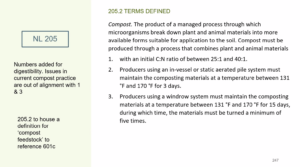
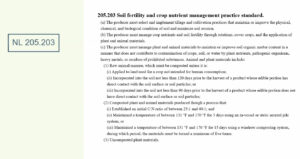
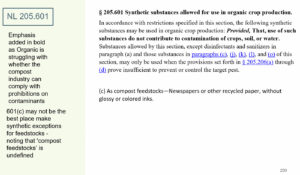
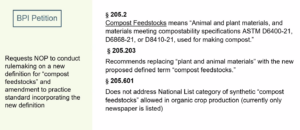
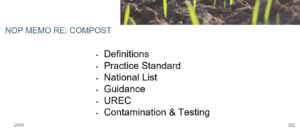
Nate Lewis: The Board is going to take on the issue of compost use in organic ag. This is a topic near and dear to Mindee and myself. Mindee actively manages a commercial composting operation. We are looking at a number of issues to discuss with the community. Issues related to compost production that we are focused on is #1 & #3 – C:N ratio and the 15 days. You can make good compost at less than 25:1, but it often takes longer than 15 days. We will be trying to align these elements with the definitions of 205.203. We see these numbers show up both in the definitions and the practice standard.
We just renewed the listing of newspaper as a compost feedstock. “Compost feedstock” does not have a definition, so we would like to focus on that. The NOP has received a petition for summary rulemaking to include a new definition of “compost feedstock.” And they recommend replacing “plant and animal materials” with a new term. This is a broad topic and touches all areas of the rule. The memo reflects that. Reviewed a slide of all of the things that might be included in this definition – definition, practice standards, NL, guidance, UREC, contamination and testing.
Dilip: I just realized that reading these regulations, and often farmers ask me the question. The C:N ration and 15 days that you mention, farmers think this is a difficult and cumbersome task for making compost. Is what you’re proposing going to be simpler for the end users?
Nate Lewis: I would be surprised if we deviated too much from that. Those #s are critical for addressing pathogens. In light of industry best practices, and the need to ensure that food is safe for consumers to eat, I do not anticipate us lightening that burden. Those #s are widely accepted and I do not anticipate seeing something to loosen those standards.
INERTS:
Brian, Logan and Franklin and myself are taking on the memo from the Program related to pesticide products in organic. Looking at options and we hope to solicit support from Esu and Heather to develop a comprehensive list and what is allowed under list 4 and various scenarios. We are in data collection mode.
Brian: Excited to be working on this and getting serious results.
Nate Powell-Palm: The last thing we are touching on is annotations. Kyla will lead the discussions.
ANNOTATIONS:
Kyla: Earlier this year we submitted agenda request for annotation changes for crops and livestock. The process I laid out is that during the spring write-up of a material, we would flag if any known annotation request by looking back at previous write-ups and public comments and using these as sources and including that in the spring write-up perhaps as a question or does the wording look good. Then during the fall write-up, if consensus around annotating, there would be 2 proposals: (1) on the sunset write-up and (2) and separate document that would be the annotation change. We haven’t done that this round b/c we got it too late. Going into 2026 sunsets to keep an eye out for annotation changes and include that as part of write-up so we can get feedback. I wrote it this way so it would remain an evergreen process as opposed to trying to fix everything we know. This doesn’t rely on humans to initiate the process which hasn’t been super effective b/c haven’t had as many changes. Will state as Jenny said earlier to be cautious because there is an impact on certifiers to verify and on others in supply chain, like farmers and processors, to implement. Where there is clarity needed, we have the mechanism to do that.
Nate: Would the annotations come as a parallel to a sunset vote?
Kyla: Yes, otherwise we will find ourselves in the sodium nitrate process. That’s why they changed the process to have no annotation changes at sunset and leaves us with an invalid listing.
Logan: Can we have a template for proposals or discussion documents for annotations so we can know impact of putting it on? Also, on sunset if we can add whether international acceptance that way we can identify it quickly?
Kyla: Trying to front-end this more, when we’re doing the TR sufficiency in the spring for the sunset materials that are going to be further out, even looking at it then would allow us to get ahead of it as much as possible.
Dilip: Trying to understand if going to work on new annotations on 2026 sunsets or revising others?
Kyla: Phosphoric acid, for example, that we just voted on. The community has said that the word “cleaner” in that is inaccurate. We would put forth the writeup on sunset as is in the spring, but somewhere in that document we would say that we are proposing to change the annotation to “whatever.” That would go out and the community would have the opportunity to comment on that.
Brian: Following up on what Logan said. Who will find out what all of the suggested annotations are for each sunset material?
Kyla: The lead for that material, and whoever the chair of the committee is.
Brian: I know that some of our stakeholders have compiled lists, as well.
Kyla: When the open docket is opened after the start of the meeting, get in annotation request for 2026 now.
Carolyn: I suppose we could also, when we put the first announcement out to the spring meeting, we could also ask if this needs an annotation?
Kyla: I feel that opening it up to “does it” in the spring is maybe a little too late, so getting more information sooner is better.
Allison: I wonder if we could make a point of posting the list of 2-years-out sunsets so that people could submit their thoughts in the fall and we’d have them for the following spring. As a person who was outside of this Board previously, I was certainly not thinking about 2-years-out materials.
Kyla: The order of the motions is going to become important. If annotation had changed it would have impacted the decision on whether to sunset it or not. Whatever we do, we should be clear which order we are going to consider these.
Carolyn: I think that we should probably assume it would take two cycles for all of the annotations to be complete. That seems like a lot of pressure to identify it before the spring meeting…I think we might say that this is a process that might take 5 years as things go through the sunset process…that would reduce my level of anxiety.
Wood: Technically this is a live process. There can always be an annotation that can come up. This process is to make it more relevant in real time, right?
Kyla: Yes. I do think, though, just to be cautious…there is definitely cleanup, I think. Once we hit 2031, we will have cleaned up the list in large part. Granted, there will be newly petitioned materials. That’s why having it “baked into” the process is good…
Nate: Allison your point got my head turning and annotation is illustrative of program’s decision not to take up annotation, right. It seems we will be giving them a second option instead of a substitute. My gears are turning.
Wood: Can we be clear about what we are talking about here? Are we saying that we want to vote on the annotation first and then the listing?
Nate: What I heard Allison say was which vote comes first might affect subsequent vote. You can vote on clean relisting in a different way. Need to be thoughtful about message sending to community about what National List looks like.
Kyla: If the community submits things into the open docket, providing the impact part would be really helpful.
Allison: I think the logistically correct way to do this, adding onto the system of sunsets being their own thing, would be that the sunset should come first, and the annotation would be a “bonus.” That way, if we do not have the annotation discussion worked out fully, the sunset issue could bleed into the spring meeting. This isn’t a clean way to do this.
Jerry: Struck me we were making a presumptive close on something. If retreated from a little bit, I’m satisfied.
Allison: I do not know that we have to decide this today, but we have to decide before we initiate this process.
Jerry: We need to be aware of workload this will put on. This is not just a little add on. I think we should start at this not with notion that every annotation is evil.
Kyla: Again, I think that being cautious here is good, and we can try to take it slow. If we voted on the annotation change first, and then that impacted someone’s vote to not renew the sunset, then it has to go to rulemaking, then you could get different stuff on rulemaking where the annotation doesn’t go through, and then there is no listing. For example, if there was an annotation change and we voted it through, and then we voted to delist the material, then the annotation change would go to a proposed rule, and if it didn’t go through…
Dr. Tucker: this gets really complicated. I think I want to build on what Kyla saying. If in same meeting you voted on an annotation and another vote to take it off the list. Guessing would do rulemaking to either leave way it is or add annotation or remove it entirely. I think we would end up doing rulemaking with multiple options in that case. We learned through sodium nitrate, we don’t want to go there. Reemphasize – be careful with annotations. Lets say a certifier says gives operation noncompliance b/c used incorrectly based on annotation. Operation appeals proposed suspension. In the past those appeals go to administrator’s office at AMS and may or may not know NL. See a poor farmer, saw on a list, and why can’t they use it. Why would we hurt farmers. experienced a few years back, not current one. If makes it to ALJ they are going to be more on farmer’s side. That’s how annotation play out on the back end.
Kyla: That makes me feel so much better, especially one rule that covers different options.
Jordan: You’re saying that we could vote liquid fish to fail to delist it and then vote the annotation to accept it, and then move it on to you, but we do not have to delist liquid fish…
Dr Tucker: concern if de-list it and also do annotation. Consider de-listing at same time consider annotation and as back-up keeping it as is. If board voted to keep on, then that would go through re-listing federal register notice. The annotation would then be considered during rule making. Public comment on annotation before rule changed.
Wood: We are going to have more things that are going to have to go to rulemaking. We’ve had many discussions about rulemaking, and delays in rulemaking, and I want to make sure that there aren’t going to be a ton of things there that are creating a log-jam to rulemaking.
Dr. Tucker: The program agrees with that concern.
Kim: Kyla, commend work. On the Board, cannot tell you how many times read a sunset and then annotation gets forgotten. Realize the complexity and appreciate thoughts b/c if we are going to make this stride we have a good group to do it.
Dr. Tucker: I don’t want my last comment to be heard as not supporting this, but I think the point is to be careful.
Amy: One comment for priorities, and this will add additional work, and we do have a lot going on. One thing the community could do is request a petition for us to have this on a work agenda item for it to rank specific. I do not see that very often that we get petition requests from the community for annotations. I think that prioritizing is going to be important, because we have to manage out other workload, as well.
Jerry: I think that first step to manageable situation is to have a gate keeper that says this one. Seemed like everyone could say “hey” but out of gate we need to find a tempo that is satisfying to the workload.
Nate Lewis: In that vein, I think that may be an area that we can buildout as an expectation for the chair of each committee to ensure workloads are managed and have the discretion to support or delay certain work.
Logan: how do we start this next year? We are close to April. We don’t have any work done on that?
Nate Lewis: In Handling, I have L-malic acid that has a classification issue of nonsynthetic/synthetic issue. Handling is a little bit ahead of other subcommittees, but I’ve already outlined that material and indicated to the subcommittee my interest in this. I think it could work that way. There are a number of changes to look for suggested annotation changes – discussion from previous comments.
Logan: I think it would be nice to have a place where we had an area where it would be easy to find these things. I guess I have to read.
Kyla: because we had so many sunsets in handling we had discussions prior to the meeting. There wasn’t any noted annotation – so baby stepping way in and once new subcommittee chairs and vice chairs get assigned that could be another flag to those folks to help.
Nate Powell-Palm: Thank you for this discussion. Excited about this work. Other business? Hearing none, we are done.
END DAY 3

